B2B websites are content powerhouses. Whether you’re navigating technical product documentation, compliance resources, white papers, or thought leadership blogs, these sites are often packed with deeply layered and jargon-heavy material. But no matter how rich your content is, it’s only valuable if users can find it. That’s where smart search functionality becomes essential.
In today’s digital landscape, B2B brands must move beyond basic keyword search to deliver an intuitive, efficient, and tailored experience that unlocks the full potential of their content. In this post, we’ll explore what smart search means for complex B2B websites and how you can use it to enhance discoverability, user experience, and business outcomes.
The Challenge of B2B Content Complexity
B2B websites tend to grow organically over time. As new products, services, use cases, and regulations emerge, pages are added—often in silos. This creates sprawling ecosystems of technical data, fragmented resources, and inconsistent metadata. For users, it can feel like searching for a needle in a haystack.
Traditional navigation tools, including outdated search bars or simplistic site maps, often fall short in helping visitors find what they need. Whether it’s a government RFP looking for product certifications or a hospital IT team seeking integration specs, your users expect fast, accurate answers. When they don’t get them, they leave.
What Is Smart Search?
Smart search—also known as advanced site search—goes far beyond the basic keyword match. It leverages technologies like artificial intelligence (AI), natural language processing (NLP), and machine learning to understand user intent and deliver relevant results.
Key capabilities of smart search include:
- Predictive search suggestions
- Typo tolerance and fuzzy matching
- Semantic understanding of queries
- Filters and faceted navigation
- Personalized results based on behavior or user roles
- Analytics dashboards to track search behavior
Popular platforms like Elasticsearch, Algolia, and Azure Cognitive Search offer these features out of the box, and many integrate seamlessly with content management systems (CMS), customer relationship management (CRM) platforms, and digital asset management (DAM) tools.
Why Smart Search Matters for B2B Sites
A smart search function does more than improve user experience—it adds measurable business value.
1. Increases Content Discoverability
Smart search enables users to easily surface relevant product pages, PDFs, datasheets, blog posts, and more—regardless of how deep they’re buried.
2. Boosts Engagement and Conversions
The faster users find what they’re looking for, the more likely they are to take action—whether that’s submitting a lead form, starting a trial, or contacting sales.
3. Provides Insight into User Needs
Site search data reveals what visitors are trying to find. This intel can drive content strategy, identify gaps, and inform UX decisions.
4. Supports Role-Based Customization
By understanding who the user is (e.g., buyer, engineer, compliance officer), smart search can tailor results to deliver the most relevant answers for each audience segment.
Key Features to Include in Your Smart Search Implementation
To maximize the impact of your search functionality, prioritize features that enhance usability and scale with your content ecosystem:
- Auto-complete and dynamic suggestions
- Faceted search filters (e.g., by product type, industry, resource type)
- Support for long-tail and natural language queries
- Contextual search snippets that preview content
- Synonym recognition and custom dictionaries
- Integration with structured metadata and tagging systems
Don’t forget to optimize for mobile—B2B users increasingly access websites from smartphones and tablets, especially in the field.
Implementation Tips for Complex Sites
Building smart search into a complex B2B website requires careful planning:
- Audit your existing content to ensure it’s structured, tagged, and organized for machine readability
- Map common user journeys to understand how different personas navigate the site
- Define your taxonomy and metadata strategy to ensure consistent tagging and filtering
- Monitor and refine search performance using analytics and feedback loops
- Collaborate across departments (marketing, IT, sales) to align on priorities and content visibility
Smart Search in Action: A Real-World Snapshot
Imagine a defense technology firm with a site housing hundreds of technical briefs, compliance documents, and product brochures. With basic keyword search, users must already know the exact title or term to find a document. But with smart search, a procurement officer typing “NIST certification for satellite hardware” can instantly access relevant materials—even if the original file is titled differently. Filters allow narrowing by document type, date, or business unit, ensuring a streamlined path to the right asset.
Turn Your Website into a Smart Content Hub
If your B2B site is packed with valuable content that users can’t easily find, it’s time to upgrade your search experience. At Bluetext, we help organizations architect advanced search solutions that integrate seamlessly into complex digital ecosystems—enhancing usability, supporting business goals, and delivering measurable ROI.
Let’s talk about how Bluetext can help you implement smart search for your site. Contact us today.
As 5G networks continue to roll out globally, marketers are beginning to tap into a new frontier of possibility. Faster speeds, ultra-low latency, and increased connectivity don’t just mean better streaming—they open the door to experiences that were previously unimaginable.
From immersive augmented reality to real-time personalization, 5G marketing is poised to redefine how brands engage with audiences. The question isn’t whether marketers should prepare for 5G, but how they’ll take advantage of it.
What Makes 5G Different?
To understand the power of 5G, think beyond speed. Yes, it’s significantly faster than 4G—but the real magic lies in ultra-low latency (the delay between action and response) and massive device connectivity. That means:
- Live experiences with virtually no lag
- Real-time data streaming and decision-making
- Simultaneous connections to thousands of devices per square mile
For marketers, these capabilities unlock creative formats and technologies that previously felt too bulky, slow, or impractical for real-world deployment.
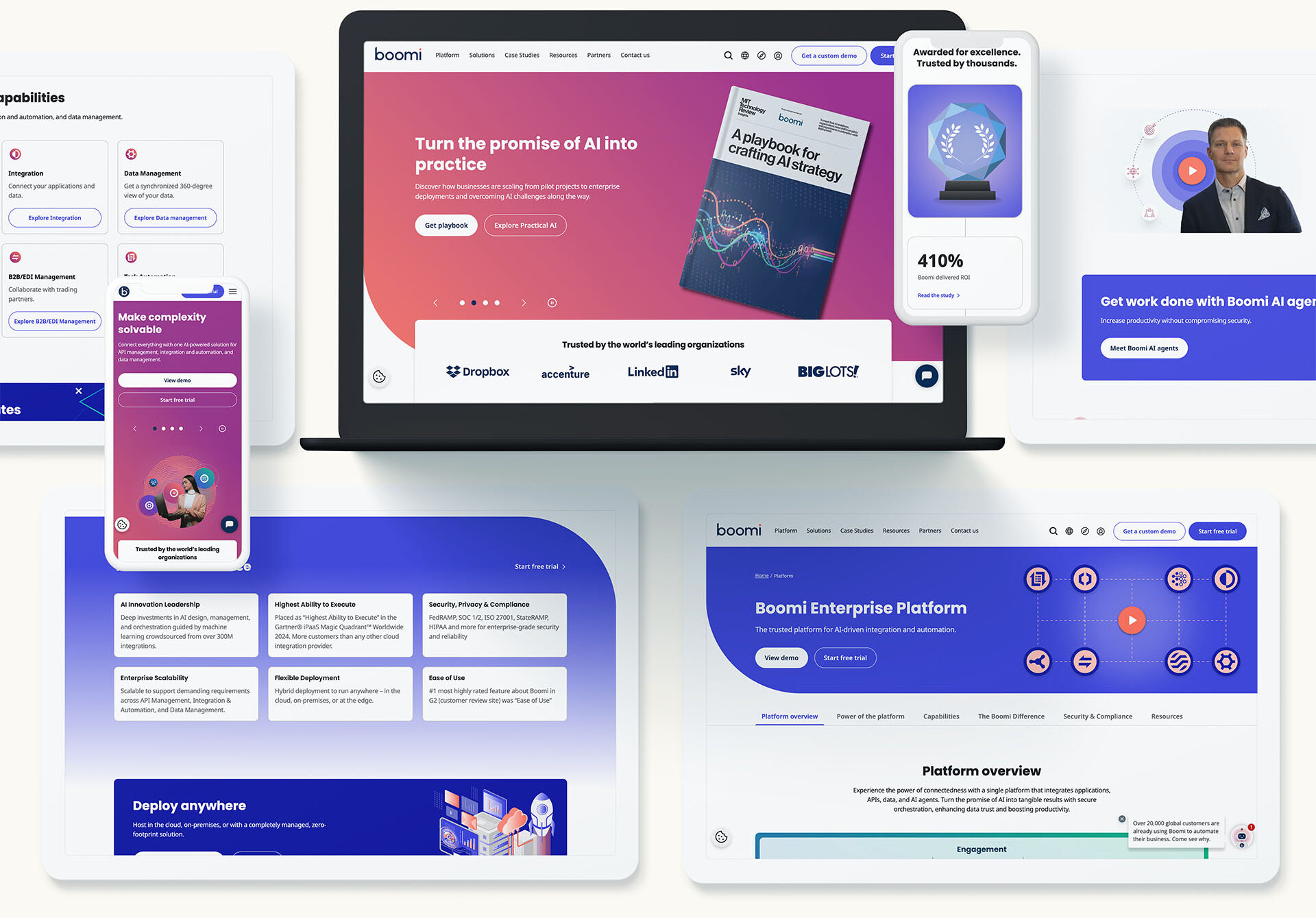
New Formats Enabled by 5G Marketing
The shift to 5G isn’t just technical—it’s creative. Here are some of the most exciting ways brands can capitalize on the format flexibility and performance of 5G:
1. Immersive AR and VR Experiences
Whether it’s a virtual showroom, branded lens, or interactive training simulation, 5G removes the friction from immersive tech. With faster loading times and real-time rendering, brands can offer AR/VR activations that feel seamless and deeply engaging—without needing users to be tethered to high-end devices.
2. Interactive Live Streams
Forget one-way livestreams. With 5G, brands can create multi-camera events, live Q&As, or choose-your-own-adventure-style broadcasts where users interact in real time. This is particularly compelling for entertainment, retail, and sports marketing.
3. Smarter Digital Out-of-Home (DOOH)
Billboards and signage are getting smarter. Thanks to 5G, dynamic DOOH ads can be updated in real time, personalized based on audience data, or made interactive via mobile engagement. Think geofenced ads that respond to foot traffic or weather conditions.
4. Real-Time Personalization at Scale
With lightning-fast connectivity and edge computing, marketers can deliver customized content in the moment—whether it’s a product recommendation, pricing adjustment, or localized offer. This could make personalization feel less like automation and more like true 1:1 engagement.

Real-World Campaign Ideas to Inspire
- A sneaker brand could launch an AR scavenger hunt across a city, with real-time rewards delivered as users complete challenges.
- A B2B tech company might host a virtual product demo where attendees can explore features in 3D and chat live with sales reps—all from their phones.
- A luxury auto brand could livestream a vehicle launch with multiple perspectives and allow viewers to control the camera angles in real time.
With 5G marketing, these ideas are no longer pipe dreams—they’re pilot-ready.
What Are the Challenges?
Of course, innovation comes with trade-offs. Some limitations to keep in mind:
- 5G network availability is still uneven, especially in rural areas.
- Creative production for immersive formats can be resource-intensive and requires specialized teams or partners.
- Not every user will be equipped with 5G-compatible devices—yet. Marketers must balance bleeding-edge experiences with accessibility and reach.
That said, adoption is accelerating, and preparing now ensures your brand isn’t playing catch-up when the tipping point arrives.

How to Get Ready for 5G Marketing
The transition to 5G isn’t something marketers need to wait for—it’s something they can build toward today. Here’s how to get started:
Invest in Flexible, Modular Content
Create content that can be reused and reassembled across formats—2D, 3D, AR, live video, etc. This sets you up to adapt quickly to evolving platforms and technologies.
Experiment with Immersive Storytelling
Start small with pilot campaigns that use basic AR filters, shoppable livestreams, or interactive mobile experiences. This builds your team’s capabilities and provides data to inform larger efforts.
Prioritize Strategic Partnerships
Work with agencies, tech providers, and platforms that are already integrating 5G-ready infrastructure. You don’t have to go it alone—collaboration is key in this new landscape.
Marketing at 5G Speed: Are You Ready?
5G isn’t just a telecom upgrade—it’s a creative unlock. For brands willing to explore its possibilities, it offers a chance to engage audiences in richer, faster, more meaningful ways than ever before.
Whether you’re launching immersive content, building personalized real-time journeys, or experimenting with smart environments, 5G marketing is where storytelling meets speed.
At Bluetext, we help forward-thinking brands push the boundaries of digital engagement. If you’re ready to explore what 5G could mean for your marketing strategy, contact us—we’re already thinking about what comes next.
In today’s fast-paced digital landscape, marketing automation is no longer a nice-to-have—it’s a necessity.
But as brands scale their operations and embrace automation tools to streamline workflows, one critical question often gets overlooked: how do you automate without losing the personal connection that customers crave?
The answer lies in building systems that prioritize marketing automation with personalization at every stage of the customer journey. Here’s how smart marketers are striking the right balance.
Why Automation Alone Isn’t Enough
There’s no denying that automation tools can dramatically improve efficiency. From scheduling email campaigns to syncing CRMs, automating repetitive tasks frees up valuable time and reduces human error.
But when automation is implemented without intention, it can lead to tone-deaf messaging, irrelevant content, and missed opportunities to build real relationships. We’ve all received emails that start with “Dear [FirstName]” or offers completely unrelated to our needs. These are the hallmarks of automation done poorly—and they erode trust fast.
Personalization Is Still the Priority
Personalization isn’t just a buzzword—it’s a baseline expectation. In fact, studies show that personalized experiences can increase conversion rates by up to 202% and drive long-term customer loyalty. The key is to use automation to enable personalization, not replace it.
That starts with understanding your audience. Automation platforms are only as good as the data behind them. Behavioral triggers, demographic segmentation, and user intent signals should all inform how, when, and why messages are delivered.
For example:
- A first-time site visitor shouldn’t receive the same email as a long-time customer.
- A lead who attended a webinar may benefit from a more detailed follow-up than someone who simply downloaded a whitepaper.
- Sales outreach should reference specific pain points or content a prospect has interacted with—not just follow a script.
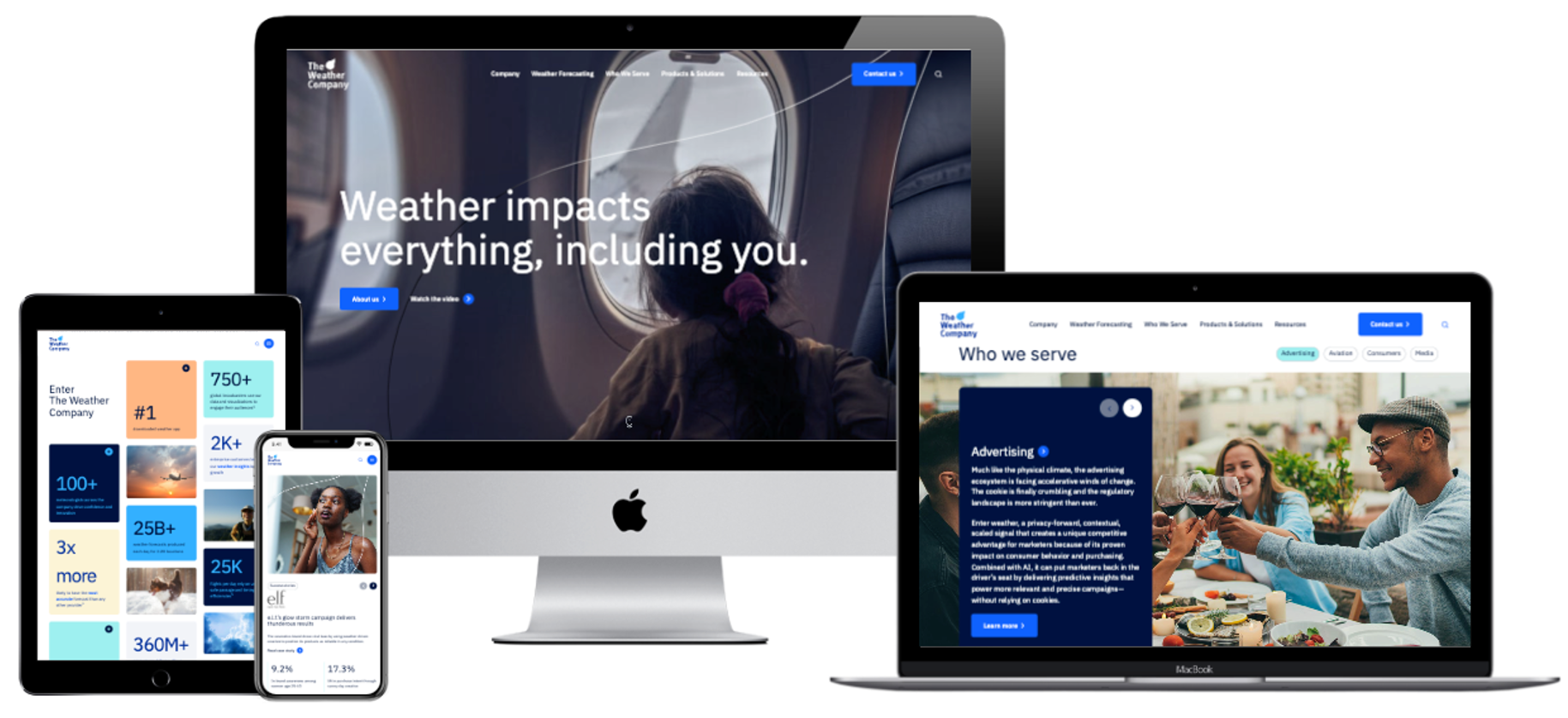
How to Build Marketing Automation with Personalization
Achieving the perfect balance requires both the right technology and a customer-centric mindset. Here’s how to make it happen:
1. Segment Intelligently
Don’t settle for basic list segmentation. Use behavioral data, purchase history, engagement levels, and funnel stage to create nuanced audience groups. This allows you to tailor messaging that feels personal—even if it’s automated.
2. Create Dynamic Content
Modern automation tools let you personalize copy, visuals, and CTAs based on user data. This means one email can feel like 10 different ones, depending on who receives it. Dynamic content is a powerful way to scale without sounding robotic.
3. Use Triggers Thoughtfully
Set up automations based on meaningful user actions—visiting a pricing page, watching a video, or abandoning a form. These are signals of intent and offer an opportunity for timely, relevant engagement.
4. Blend Automation with Human Touchpoints
Automation shouldn’t eliminate real conversations. Use it to set the stage for sales outreach, customer service, or live chats. For instance, a well-timed email can invite a lead to schedule time with a rep, while internal alerts can prompt sales to follow up personally.
5. Audit Regularly
Automated workflows should evolve. Set up regular reviews to ensure messaging is still aligned with user needs, brand voice, and current campaigns. What worked six months ago might feel tone-deaf today.

Human-Centric Marketing at Scale
Marketing automation isn’t the enemy of personalization—it’s the engine that can power it. When used thoughtfully, it can enhance customer experience, increase efficiency, and drive measurable growth.
The secret is remembering that behind every click, open, and conversion is a real person. Automation should help you speak to that person more effectively—not just more often.
Humanizing Automation: A Competitive Advantage
In a world where inboxes are flooded and attention is fleeting, personalization is your brand’s biggest differentiator. The companies that win aren’t the ones sending the most emails—they’re the ones sending the right emails, at the right time, with the right tone.
At Bluetext, we help brands build marketing automation strategies that scale performance without sacrificing personality. If you’re looking to automate your operations while staying authentically connected to your audience, contact us—we’ll help you make every interaction count.
Customers today expect more than just fast answers—they want smart, personalized conversations. As brands look to automate support, streamline lead qualification, and create always-on digital experiences, the choice often comes down to two options: rule-based chatbots and conversational AI.
But which one is right for your brand?
Understanding the difference—and knowing when to use each—can help you design a more strategic and scalable customer experience. Here’s how to navigate the landscape and make the best decision for your business.

Chatbots vs. Conversational AI: What’s the Difference?
Although the terms are often used interchangeably, rule-based chatbots and conversational AI serve fundamentally different purposes.
Rule-Based Chatbots
These are logic-driven tools that operate on pre-defined workflows. They follow “if-this-then-that” logic and guide users through scripted paths.
- How they work: Pre-programmed responses triggered by keywords or button clicks
- Strengths: Fast, simple, low-cost
- Common uses: FAQs, order tracking, appointment booking, password resets
Conversational AI
This advanced solution uses natural language processing (NLP), machine learning, and real-time data to understand user intent, even with vague or complex phrasing.
- How it works: Interprets open-ended input, accesses data in real time, and improves through continuous learning
- Strengths: Context awareness, personalization, multilingual support
- Common uses: Lead qualification, customer support at scale, employee onboarding, post-sale care
| Feature | Rule-Based Chatbot | Conversational AI |
| Response Type | Predefined | Adaptive / Generated |
| Learning Capability | None | Learns over time |
| Input Handling | Buttons or keywords | Natural language input |
| Complexity | Low to moderate | High |
| Setup Time | Quick | Longer (training + testing) |
| Cost | Lower | Higher (but scalable) |
When a Rule-Based Chatbot Makes Sense
Not every brand needs a cutting-edge AI assistant. In many cases, a simple chatbot can be a powerful tool.
Rule-based bots are ideal when:
- The user journey is highly predictable. For example, booking appointments or answering standard questions.
- You’re operating with limited budget or technical resources. These bots are quicker and cheaper to build and deploy.
- Speed to market is essential. Launch a minimal viable chatbot in weeks, not months.
For organizations with well-defined user queries and limited support volume, rule-based bots offer a reliable and efficient solution.

The Power of Conversational AI
If your customer experience demands nuance, personalization, or scale, conversational AI brings transformative potential.
Key Benefits:
- Contextual understanding: Responds to natural language, recognizes user intent, and adapts mid-conversation
- Personalized responses: Pulls data from CRMs and other sources to deliver tailored experiences
- 24/7 learning: Gets smarter with every interaction, improving accuracy and engagement
- Multilingual capabilities: Supports global audiences seamlessly
- Omnichannel delivery: Integrates across web, mobile, voice, and social platforms
For example, an AI-powered assistant could qualify leads on your website, prioritize inquiries based on urgency, and transfer complex cases to live agents—all while learning and refining its responses over time.
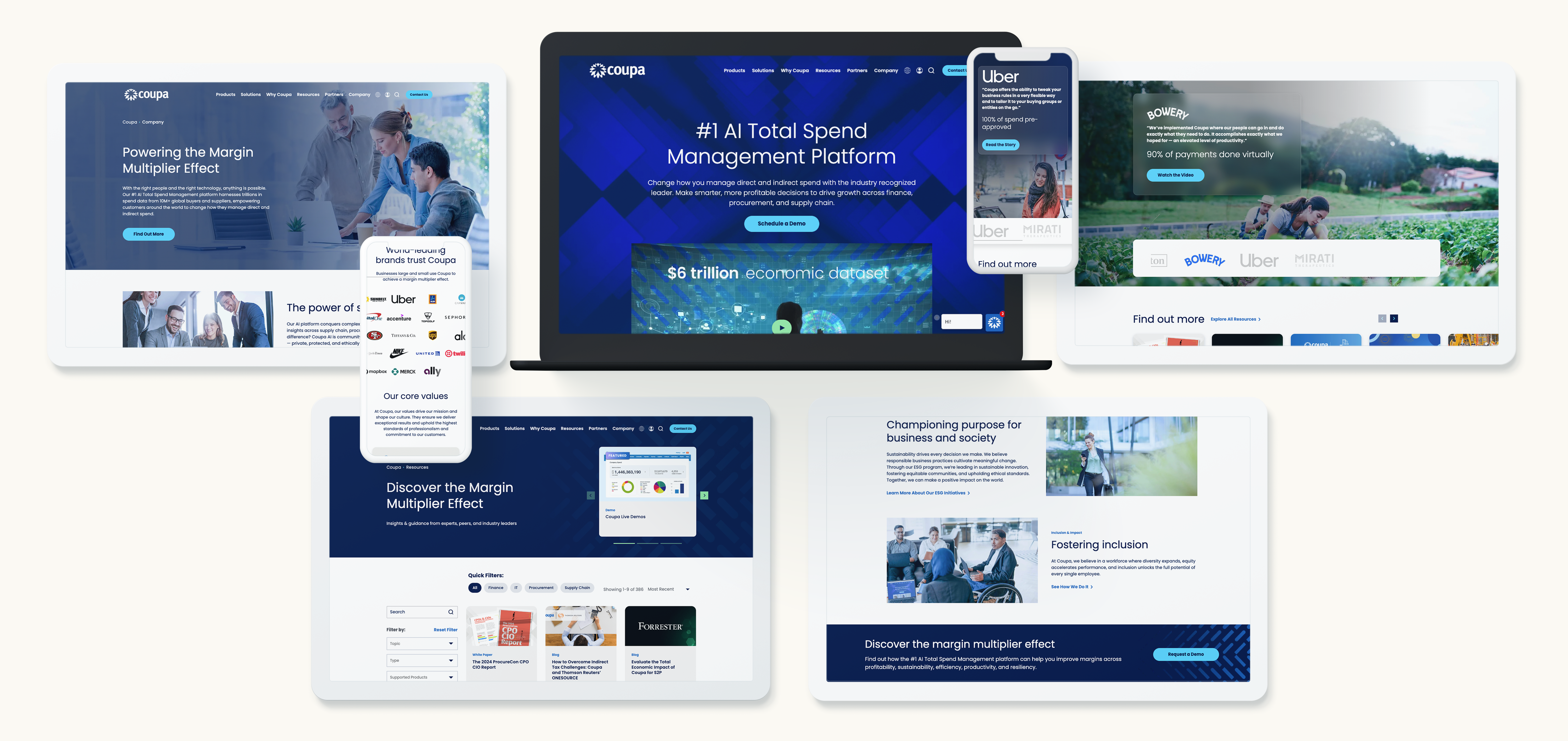
Choosing the Right Tool for Your Brand
Before jumping into a chatbot or AI deployment, consider:
- The complexity of your customer journeys: Do users have multiple paths and nuanced questions?
- Support volume and scale: Are you managing hundreds—or thousands—of interactions daily?
- Integration needs: Do you need to pull in CRM data, ticketing platforms, or product catalogs?
- Timeline and budget: What can you realistically implement and maintain?
You may not need to choose just one. Many organizations start with rule-based chatbots, then layer in conversational AI features over time—a hybrid approach that balances speed and sophistication.
Future-Proofing Your Customer Experience
The future of customer engagement is conversational—and increasingly intelligent.
Emerging trends include:
- Voice-enabled AI: For hands-free customer support and smart device integration
- Emotion-aware AI: That can detect tone and sentiment to adjust responses accordingly
- No-code AI tools: Making it easier for marketers to train and deploy AI without relying heavily on developers
- Unified conversational platforms: That bring together chat, email, social, and voice under a single AI-powered framework
As these technologies mature, the brands that win will be those who design experiences around real user needs—not just the latest tech.
Ready to build a smarter digital experience? Whether you’re just starting with chatbots or exploring AI-powered transformation, Bluetext can help you create a conversational strategy that connects.
In today’s business landscape, mergers, acquisitions, and IPOs aren’t just transactions—they’re strategic leaps. Whether it’s a defense contractor expanding its mission set, a fintech firm going public to scale, or a cybersecurity company consolidating talent and tech, every move tells a story about where an industry is headed.
At Bluetext, we help organizations position themselves for these defining moments. That’s why we took a closer look at 95 notable transactions—each of which occurred within 24 months following a Bluetext engagement. From landmark deals like VMware’s acquisition by Broadcom to precision plays like CyberArk’s IPO and BlueHalo’s acquisition by AeroVironment—to understand the trends shaping the business world in 2026 and beyond.
In this comprehensive overview, we delve into 95 significant transactions that have shaped various industries. Each transaction is accompanied by a concise summary and an analysis of the strategic advantages of the merger, IPO, or acquisition.
95. TransDigm Group Acquires Stellant Systems
Summary: TransDigm Group, a leading global designer, producer, and supplier of highly engineered aerospace components, has acquired Stellant Systems, a specialized provider of RF and microwave solutions supporting defense and space missions. Stellant brings deep expertise in radar, electronic warfare, communications, and satellite payload technologies, serving critical national security and aerospace programs. The acquisition strengthens TransDigm’s portfolio of proprietary, mission-critical products that support complex and highly regulated aerospace and defense platforms.
Strategic Advantages: By integrating Stellant’s advanced RF and microwave capabilities, TransDigm expands its presence in high-growth defense and space markets where performance, reliability, and technical differentiation are paramount. Stellant’s offerings complement TransDigm’s existing portfolio by adding specialized electronic subsystems that are deeply embedded in customer platforms and programs of record, reinforcing TransDigm’s position as a trusted supplier of highly engineered, value-added components.
Strategically, the acquisition underscores TransDigm’s disciplined approach to M&A, focusing on businesses with strong intellectual property, long program lifecycles, and defensible market positions. Stellant’s alignment with classified and mission-critical applications enhances TransDigm’s exposure to resilient defense and space spending while creating opportunities for long-term value creation through operational excellence, aftermarket support, and sustained customer relationships across the aerospace and defense ecosystem.
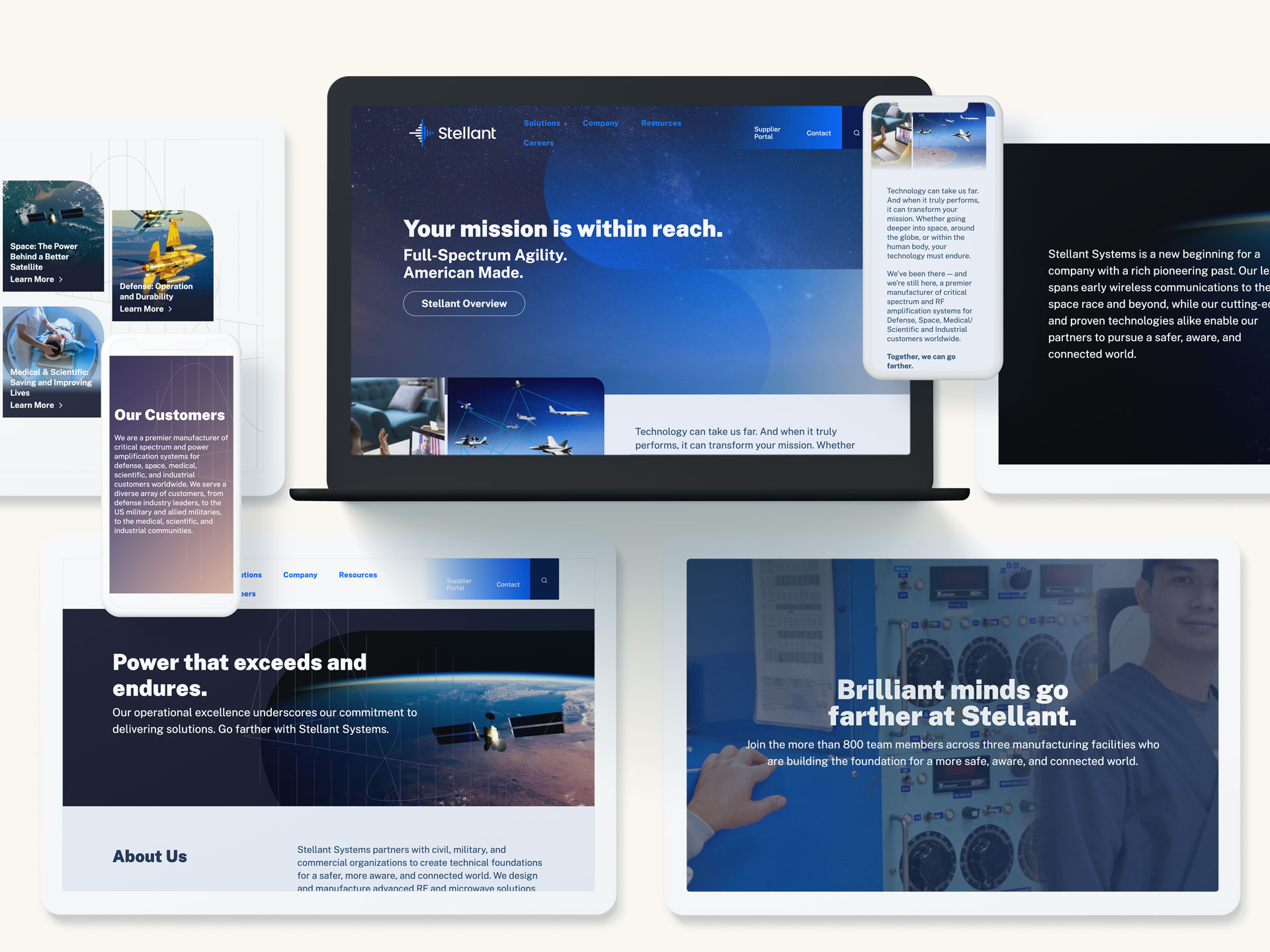
94. CACI Acquires ARKA Group
Summary: CACI, a leading provider of advanced technology and intelligence solutions for defense, federal, and commercial clients, has acquired ARKA Group, a specialized firm focused on space-based sensing, actionable intelligence, and advanced technology integration. ARKA brings expertise in sensor systems, data fusion, analytics, and mission-focused technology solutions across national security and defense operations. This acquisition strengthens CACI’s ability to deliver end-to-end, mission-centric capabilities that combine cutting-edge technology with operational insight.
Strategic Advantages: By integrating ARKA’s space and sensor capabilities, CACI enhances its position in domains where situational awareness, data-driven decision-making, and rapid response are critical. ARKA’s offerings expand CACI’s portfolio from core intelligence, cyber, and mission services into advanced space-based sensing, analytics, and technology integration—enabling defense and intelligence clients to achieve faster, more precise outcomes.
Strategically, the acquisition demonstrates CACI’s commitment to delivering innovative, mission-aligned solutions to national security customers. It creates opportunities for unified technology development across CACI’s platforms, blending sensor technology, analytics, mission systems, and actionable intelligence. The combined capabilities provide clients with a trusted partner capable of addressing complex operational challenges and emerging threats in a rapidly evolving security environment.
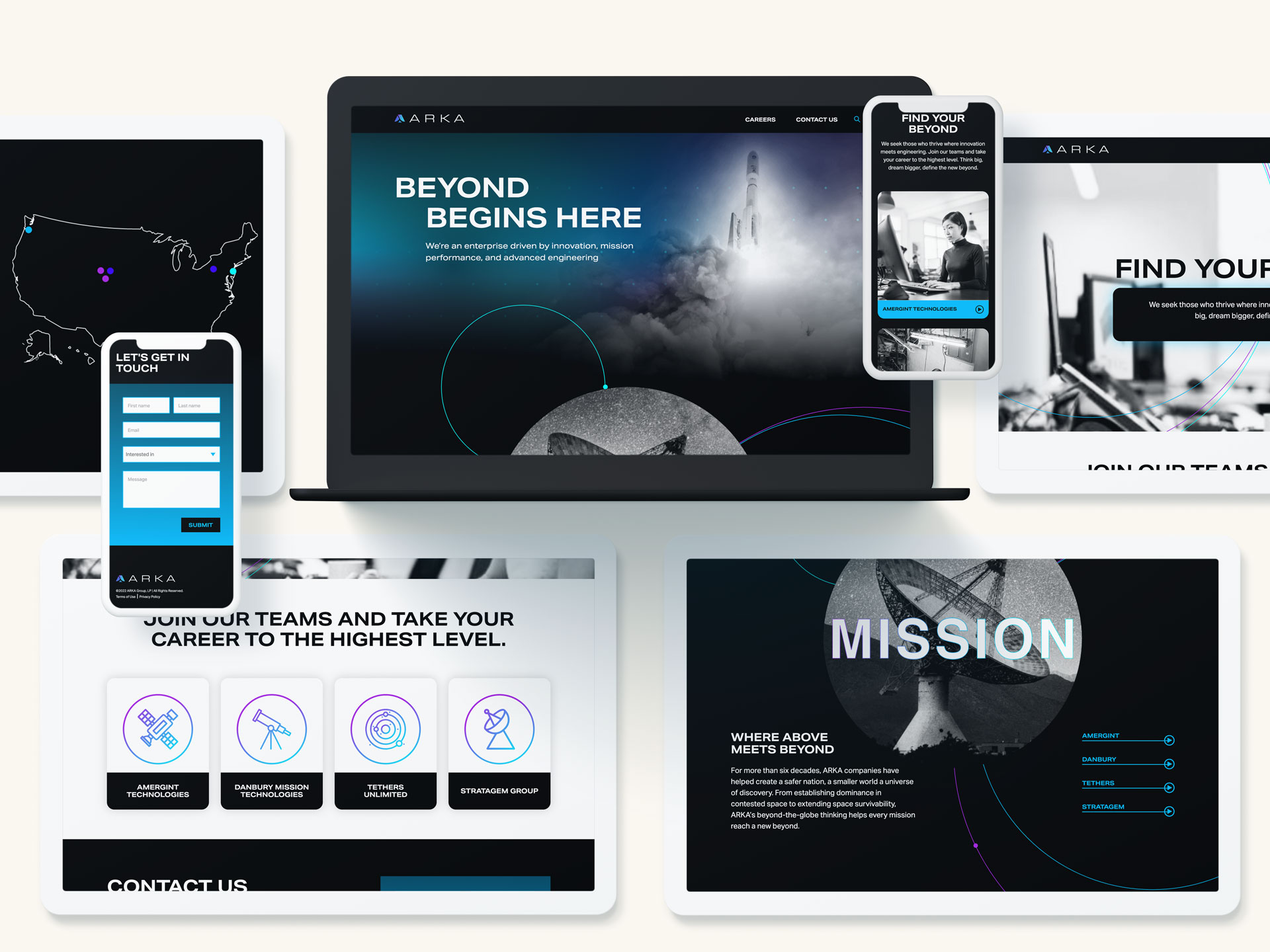
93. Red River Acquires Invictus
Summary: Red River, a leading provider of technology transformation, security, and managed services for government and enterprise clients, has acquired Invictus, a specialized cybersecurity and intelligence solutions firm supporting national security missions. Invictus brings deep expertise in cyber operations, intelligence analysis, secure systems engineering, and mission support services across defense, intelligence, and federal civilian agencies. The acquisition enhances Red River’s ability to deliver end-to-end, mission-focused solutions that combine advanced cybersecurity capabilities with scalable IT modernization.
Strategic Advantages: By integrating Invictus’s cyber and intelligence tradecraft, Red River significantly strengthens its position in high-security environments where resilience, protection, and operational readiness are paramount. Invictus’s capabilities expand Red River’s portfolio from core IT and cloud services into advanced cyber operations, intelligence support, and mission assurance—helping federal clients counter evolving threats with greater speed and precision.
Strategically, the acquisition underscores Red River’s commitment to supporting national security customers with secure, enterprise-grade technologies backed by deep domain expertise. It creates opportunities for unified solution development across Red River’s existing platforms, blending infrastructure modernization, cybersecurity, analytics, and managed services. The combined offering delivers greater value to defense and intelligence clients seeking trusted partners who understand both mission complexity and emerging threat landscapes.
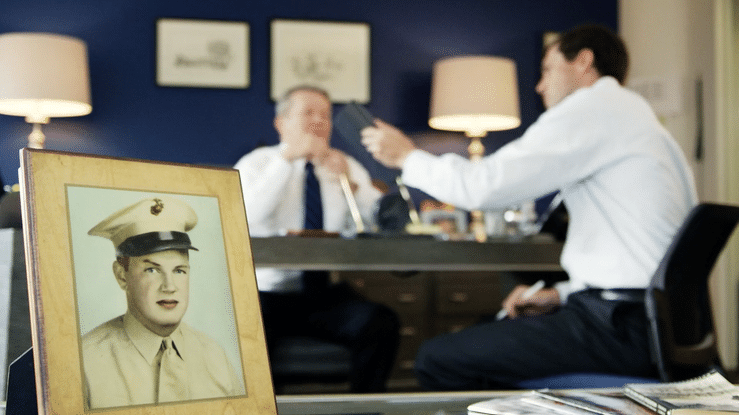
92. BigBear.ai Acquires Ask Sage
Summary: BigBear.ai, a leader in artificial intelligence and data analytics solutions for defense and enterprise customers, has acquired Ask Sage, an AI-powered research and decision-support platform. Ask Sage leverages generative AI to accelerate access to knowledge, providing natural-language answers across secure and classified environments. The acquisition enhances BigBear.ai’s ability to deliver trusted, explainable AI solutions tailored for mission-critical applications in government, intelligence, and commercial sectors.
Strategic Advantages: By integrating Ask Sage’s generative AI technology, BigBear.ai strengthens its position at the intersection of data analytics and large language model (LLM) innovation. The acquisition enables BigBear.ai to expand its offerings beyond analytics into interactive decision-support and real-time knowledge generation, improving speed and insight for end users.
Strategically, this move underscores BigBear.ai’s commitment to advancing AI solutions that are secure, transparent, and operationally relevant—particularly in regulated and high-security domains. It also opens opportunities for product integration across BigBear.ai’s existing platforms, enhancing value for both defense and enterprise clients seeking intelligent automation.
91. Paychex Acquires SixFifty
Summary: Paychex, a leading provider of human resources and payroll solutions, has acquired SixFifty, the legal technology subsidiary of Wilson Sonsini Goodrich & Rosati. SixFifty, launched in 2019, offers a platform that automates employment compliance, providing businesses with access to employment law databases and tools to generate documents such as hiring and separation agreements. The acquisition represents a major expansion of Paychex’s capabilities, adding lawyer-built legal compliance solutions to its existing suite of HR, payroll, and benefits technologies. The deal underscores Paychex’s commitment to helping businesses manage risk, maintain compliance, and streamline administrative processes through technology.
Strategic Advantages: By integrating SixFifty’s legal tech platform, Paychex strengthens its position as an end-to-end solution for business operations, combining HR, payroll, benefits, and now employment law compliance. SixFifty’s automated workflows and document-generation capabilities reduce reliance on external legal counsel for routine employment matters, allowing businesses to scale efficiently while minimizing legal risk.
The acquisition also opens opportunities for cross-selling, enabling Paychex to offer SixFifty’s compliance tools to its extensive customer base, deepening client relationships and enhancing customer retention. Strategically, this move reflects the growing trend of blending legal expertise with operational technology, positioning Paychex to provide businesses with a unified, tech-driven approach to managing both workforce and regulatory challenges.
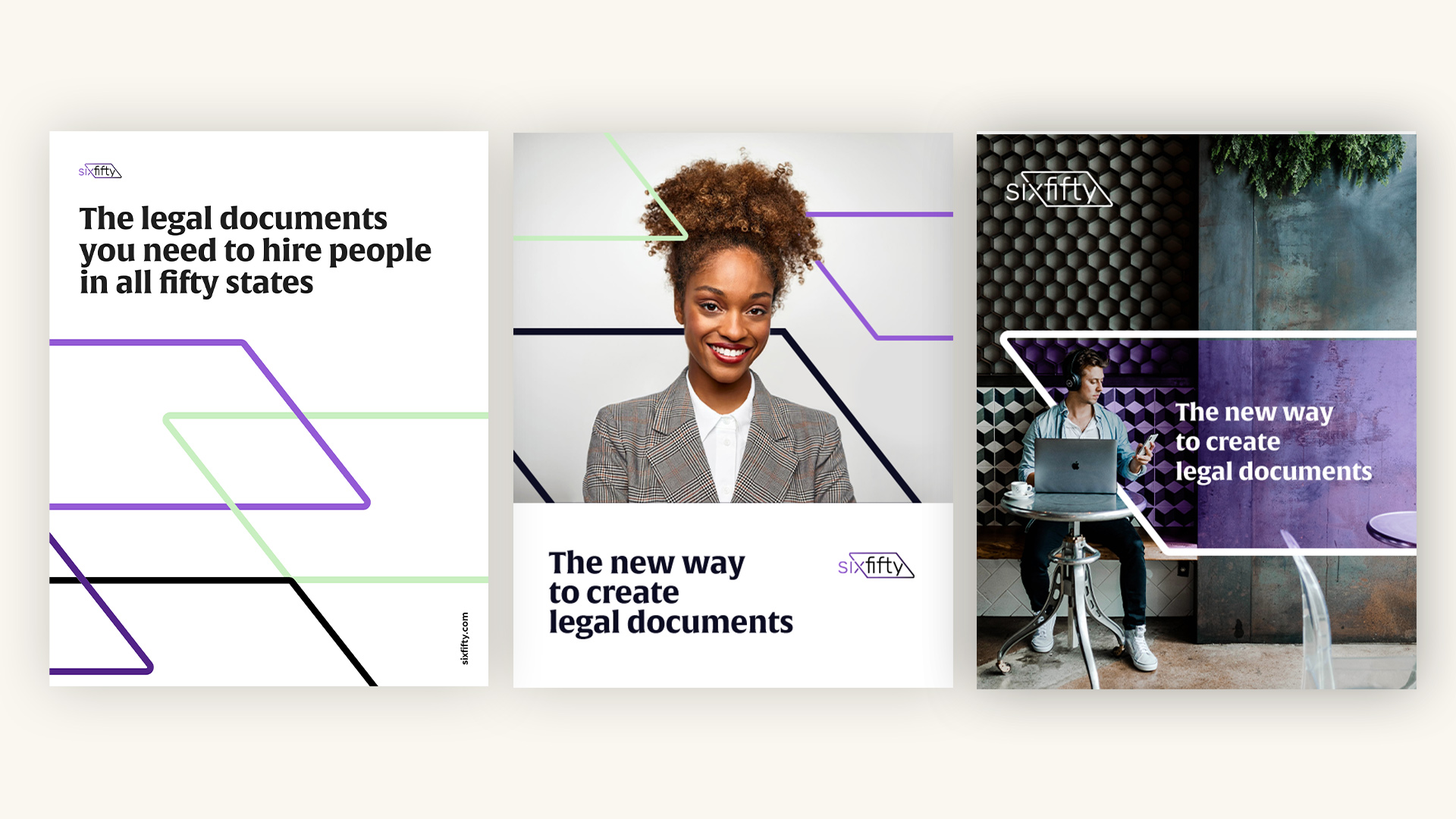
90. Palo Alto Networks Acquires CyberArk
Summary: Palo Alto Networks acquired CyberArk, a global leader in Identity Security and privileged access management. The deal marks a significant expansion of Palo Alto’s platform strategy, adding a robust identity layer to its network, cloud, and endpoint security offerings. CyberArk’s solutions—trusted by governments and Fortune 500 companies alike—bring deep expertise in managing human and machine identities, protecting critical infrastructure from insider threats, credential theft, and unauthorized access. The acquisition reflects Palo Alto’s belief that identity is no longer a standalone concern but a foundational element of modern cybersecurity architecture, especially as AI agents and machine-to-machine workflows take on increasingly sensitive roles within the enterprise.
Strategic Advantages: The acquisition of CyberArk significantly enhances Palo Alto Networks’ platform by embedding industry-leading Identity Security capabilities into its broader cybersecurity architecture. As organizations face mounting challenges in securing not just users but also machines and autonomous AI agents, CyberArk’s technology provides the privileged access controls, secrets management, and identity governance tools required to manage this growing complexity. By integrating these capabilities into its existing suite of network, cloud, and endpoint security solutions, Palo Alto can offer customers a unified security platform that secures access across every layer of their operations.
The combination also strengthens Palo Alto’s positioning for the AI-powered enterprise, where identity becomes a cornerstone of real-time threat prevention and autonomous decision-making. CyberArk’s just-in-time and least-privilege access models are especially well suited for managing the permissions and behaviors of AI agents operating with sensitive data and systems. Strategically, the deal enables cross-selling opportunities, deepens customer relationships, and consolidates the security stack under fewer vendors—all while expanding Palo Alto’s footprint across both public and private sector identity programs. The move marks a step-change in how identity is treated: not as a point solution, but as an essential layer of enterprise cybersecurity infrastructure.

89. Thrive Acquires Abacode
Summary: Thrive, a global technology outsourcing provider specializing in cybersecurity, cloud, and managed IT services, has completed the acquisition of Abacode, a Tampa-based Managed Cybersecurity & Compliance Provider (MCCP). Abacode’s outcome-driven approach combines cybersecurity, governance, risk management, and compliance into a unified offering. By integrating Abacode’s team and capabilities, Thrive enhances its ability to help mid-market clients across healthcare, finance, government, and other regulated industries meet evolving regulatory and cyber risk requirements while turning compliance into a competitive advantage.
Strategic Advantages: The acquisition seamlessly aligns Thrive’s global, scalable infrastructure with Abacode’s proven expertise in managing compliance-intensive cybersecurity programs. Abacode’s culture of client commitment and innovation strengthens Thrive’s high-touch, advisory-led delivery model featuring vCISO, vCIO, and 24×7 SOC/NOC services. Together, they deliver a comprehensive governance, risk, and compliance platform that simplifies complexity for mid-market businesses. This union accelerates Thrive’s expansion of its compliance capabilities and presence, particularly in the Southeast US, while deepening its value proposition across industries facing stringent regulatory environments. With enhanced scale, standardized services, and integrated compliance and security advisory, the combined offering positions Thrive to drive scalable, high-touch cybersecurity outcomes for a broader range of clients.
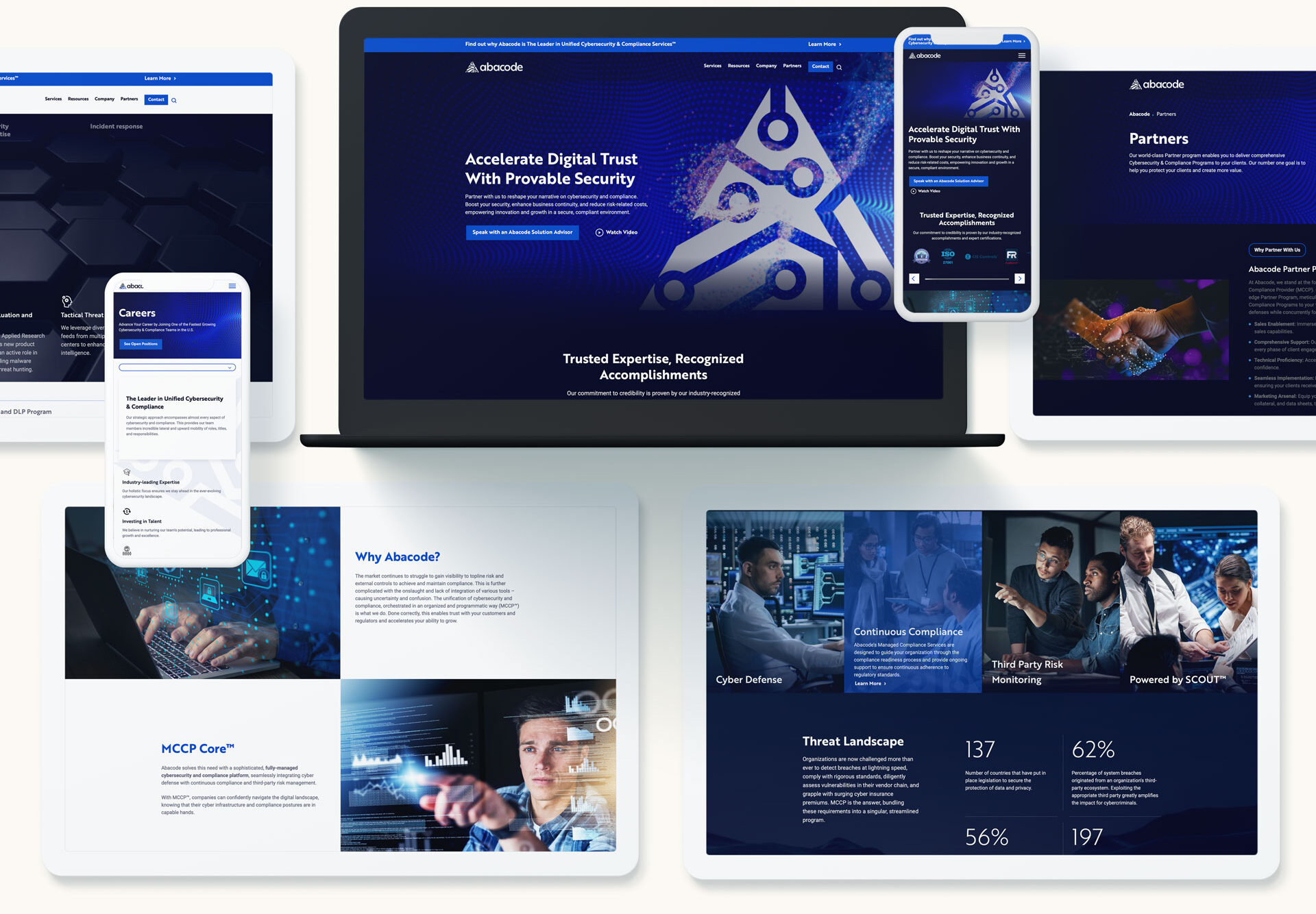
88. Clinisys Acquires Orchard Software
Summary: Clinisys, a global provider of laboratory informatics solutions, has acquired Orchard Software from Francisco Partners. This transaction unites two leading names in the Laboratory Information System (LIS) market and reinforces Clinisys’s commitment to expanding its informatics capabilities across healthcare, life sciences, and public health. Orchard brings a deep bench in award-winning LIS solutions used across physician offices, reference labs, student health centers, veterinary clinics, and public health organizations. The combination enhances Clinisys’s ability to offer comprehensive, flexible, and scalable cloud and enterprise-level software to laboratories worldwide.
Strategic Advantages: The acquisition delivers powerful complementary strengths: Clinisys’s global footprint and cloud-native LIMS offerings merge with Orchard’s dominance in diagnostic laboratories, particularly in physician office, veterinary, and independent reference lab settings. Together, they form a unified, versatile platform capable of serving the full spectrum of laboratory customers with consistent, integrated software and analytics. Orchard’s long-standing recognition in customer satisfaction and performance metrics reinforces Clinisys’s leadership in the LIS market and accelerates innovation in workflow automation, billing enhancements, and integration with EHR systems.
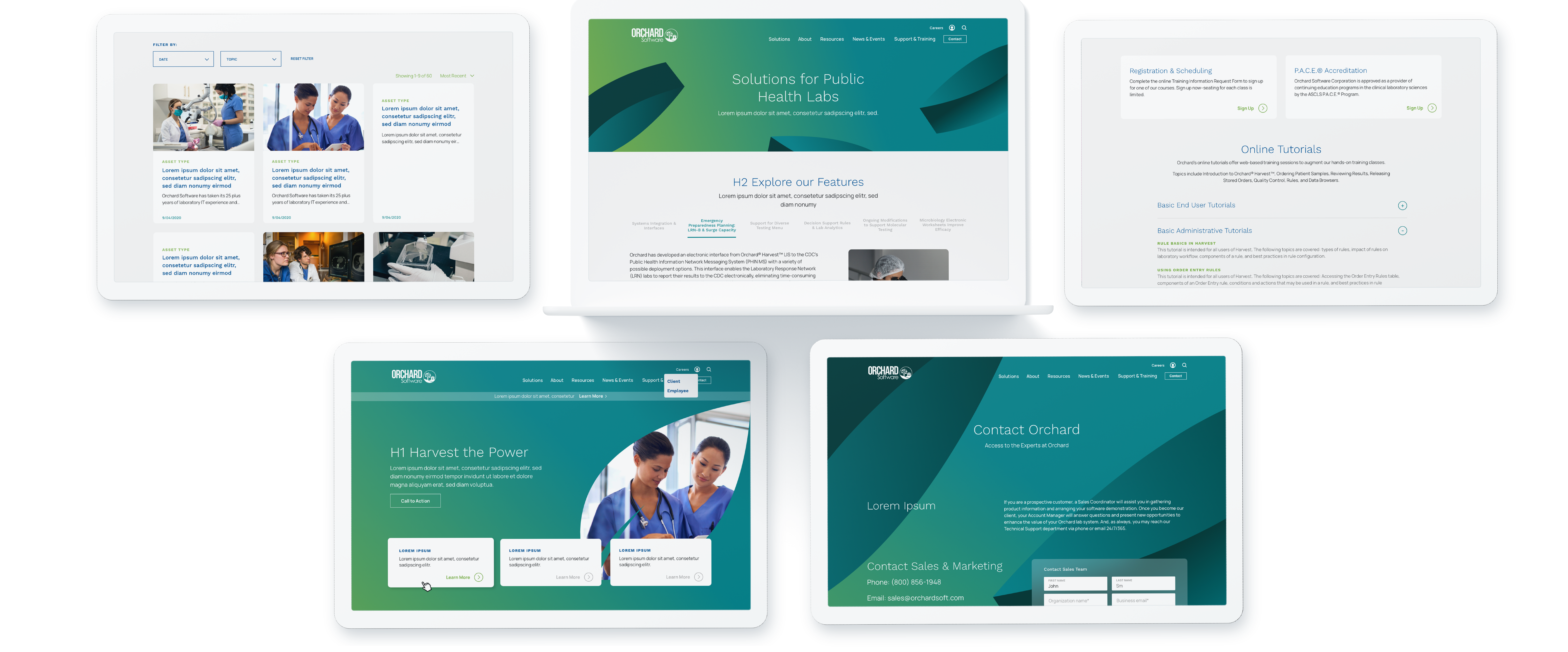
87. Anduril Acquires Klas
Summary: Anduril Industries acquired KLAS, a leading provider of advanced sensor and targeting technologies for defense and intelligence applications. KLAS specializes in high-performance radar and electro-optical systems critical to situational awareness and battlefield intelligence. This acquisition strengthens Anduril’s portfolio in autonomous defense solutions by integrating KLAS’s proven capabilities in sensor fusion and target tracking. The move underscores Anduril’s commitment to delivering next-generation, end-to-end defense platforms that enhance real-time decision-making across contested environments.
Strategic Advantages: KLAS’s expertise in multi-sensor integration and scalable, ruggedized hardware complements Anduril’s autonomous systems, creating a seamless pipeline from detection to engagement. The acquisition enables accelerated development of AI-powered situational awareness tools, bolstering capabilities in drone defense, perimeter security, and battlefield monitoring. KLAS’s deep relationships with key DoD customers and classified programs provide Anduril with expanded access to mission-critical markets and classified contracts. By combining Anduril’s software-defined autonomy with KLAS’s sensor innovation, the company is positioned to lead in delivering agile, modular defense solutions optimized for rapid deployment and evolving threats.
86.Vista Equity Partners and Blackstone Acquire Assent
Summary: Vista Equity Partners, in partnership with Blackstone, has acquired a controlling stake in Assent Inc., a leading provider of supply chain sustainability and compliance software headquartered in Ottawa. The transaction involved buying out prior venture investors—namely Volition Capital, First Ascent Ventures, Warburg Pincus, and StepStone Group—under a valuation in the neighborhood of US$1.3 billion, with a reported cash payment of approximately US$400 million to exiting shareholders. Assent’s platform supports enterprise clients in highly regulated manufacturing sectors, enabling them to manage supply chain risk, regulatory compliance, and ESG data through a scalable cloud-based SaaS solution. Concurrent with the ownership shift, the company appointed a new CEO from the United States and transitioned the founder‑CEO into an executive chairman role.
Strategic Advantages: This investment strengthens Assent’s trajectory toward scaling global operations by aligning it with two of the most influential enterprise software‐focused private equity firms. Assent gains access to Vista’s deep operational playbook in scaling SaaS businesses and Blackstone’s capital scale and institutional strength. Together, the firms bring governance rigor and roadmap alignment that can accelerate Assent’s evolution from steady recurring revenue growth to broader international expansion and deeper vertical penetration across industrial sectors. With momentum driven by a history of reliable ARR growth and adoption by nearly a thousand large manufacturers, Assent is well positioned to broaden its product and partnership ecosystem in supply chain compliance, ethical sourcing, and ESG risk management. The board reconfiguration and new executive leadership are structured to support an intensified focus on growth objectives, operational scale, and customer success, building on the company’s established track record and board alignment with Vista and Blackstone principals.
85. Karman Space & Defense Files for IPO
Summary: In early 2025, Karman Space & Defense confidentially filed for an initial public offering, positioning itself as one of the first pure-play space and hypersonics manufacturers to seek a public listing. Formed through the combination of multiple heritage aerospace and defense suppliers—most notably AAE Aerospace, Systima Technologies, and Bal Seal Engineering—Karman has rapidly scaled into a vertically integrated supplier of mission-critical hardware for the space launch, missile defense, and hypersonic sectors. The IPO marks a milestone not just for Karman, but for the broader emergence of space-adjacent industrial players as viable public-market entities.
Strategic Advantages: Karman’s growth story is driven by consolidation, modernization, and smart positioning. By integrating legacy defense suppliers under one roof, it built a scalable manufacturing footprint tailored for the new space race—supporting both commercial launch providers and prime contractors. Its capabilities span nose cones, separation mechanisms, and propulsion-adjacent hardware—essential components for both reusable launch systems and advanced missile architectures. Karman’s competitive edge lies in its speed-to-market, vertically integrated facilities, and ability to deliver high-reliability components at production scale. With government investment in hypersonics and resilient space architectures rising sharply, Karman sits in the sweet spot: a defense-grade manufacturer that’s nimble enough to support new entrants like Rocket Lab or Firefly, but qualified enough for classified DoD and MDA programs.
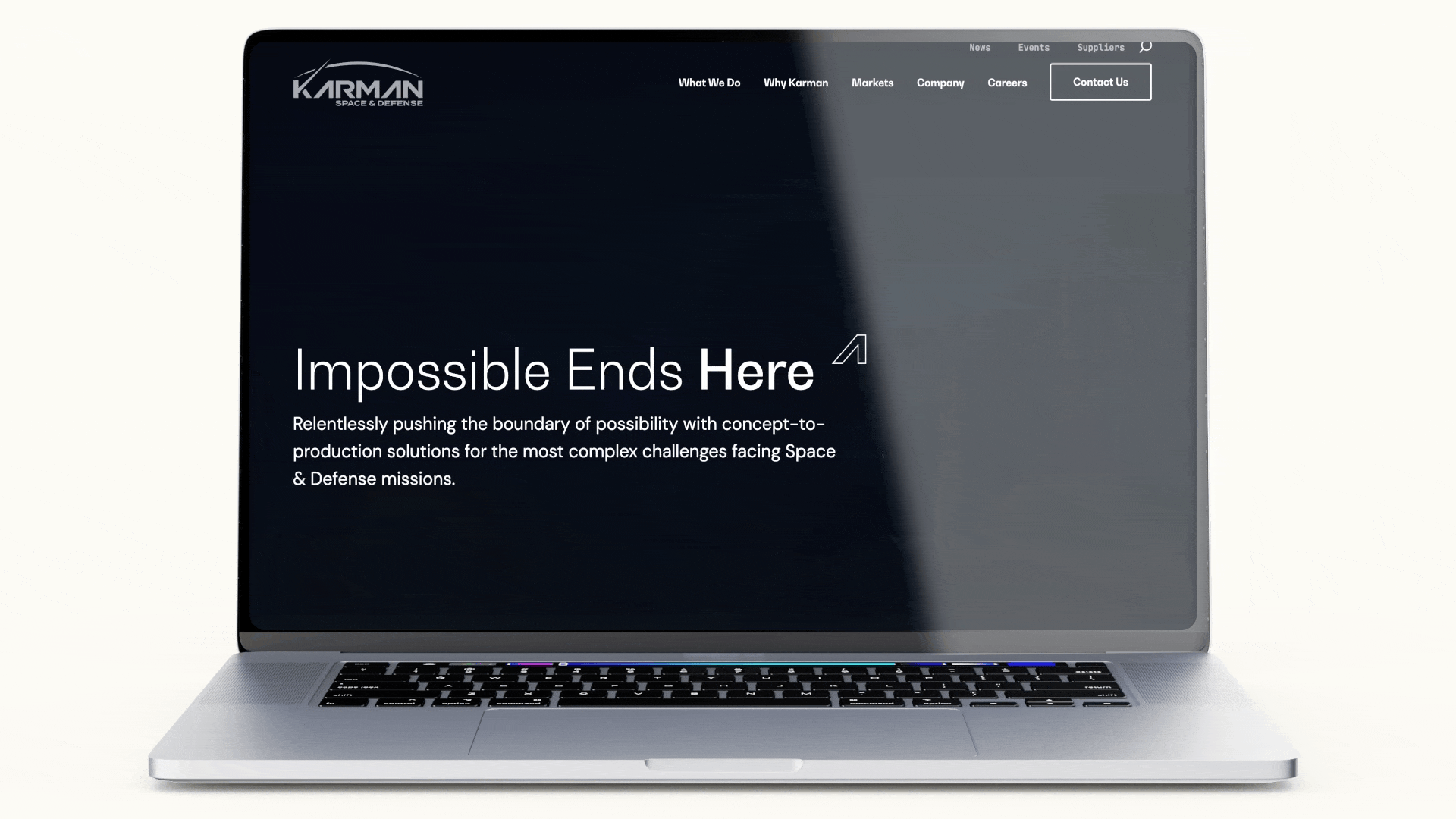
84. Quorum Cyber Acquires Kivu Consulting
Summary: Quorum Cyber, a fast-growing cybersecurity firm specializing in managed detection and response (MDR) services, has acquired Kivu Consulting, a U.S.-based cybersecurity and digital forensics provider. Kivu is known for its expertise in ransomware response, digital investigations, and cyber risk management, serving enterprises and insurers worldwide. The acquisition significantly expands Quorum Cyber’s incident response and forensic capabilities while strengthening its North American presence. Together, the two firms will offer a full spectrum of proactive and reactive cybersecurity services, from threat monitoring to breach response and recovery.
Strategic Advantages: The addition of Kivu enhances Quorum Cyber’s ability to provide rapid, end-to-end cyber resilience solutions. Kivu’s experience handling complex incidents and insurance partnerships complements Quorum Cyber’s managed security operations, enabling a more integrated and global service offering.
The acquisition also positions Quorum Cyber to compete more aggressively with large-scale security service providers by combining operational excellence with specialized response expertise. Strategically, this move aligns with increasing enterprise demand for unified cybersecurity partners capable of managing prevention, detection, and response under a single umbrella.
83. AeroVironment Acquires BlueHalo
Summary: In early 2025, defense technology leader AeroVironment acquired BlueHalo, a rapidly growing provider of advanced defense solutions spanning space, directed energy, cyber, and AI/ML-powered C5ISR systems. BlueHalo, backed by Arlington Capital Partners, had grown aggressively through acquisitions and internal R&D, carving out a leadership position in cutting-edge national security tech. AeroVironment, traditionally known for tactical UAS (unmanned aerial systems), positions this acquisition as a strategic leap into the higher end of the defense technology spectrum.
Strategic Advantages: This acquisition gives AeroVironment access to BlueHalo’s advanced capabilities in space and directed energy—domains increasingly prioritized in the Pentagon’s modernization roadmap. BlueHalo’s portfolio also includes proprietary technologies in autonomy, AI/ML, and RF engineering, which enhance AeroVironment’s offering beyond small UAS. The combined entity now covers a broader mission set: from tactical ISR and loitering munitions to space domain awareness and counter-UAS defense systems. BlueHalo’s government customer base (including key classified programs and defense R&D agencies) complements AeroVironment’s existing DoD footprint, while BlueHalo’s East Coast presence (HQ in Arlington, VA, plus facilities in Alabama, New Mexico, and Maryland) expands AeroVironment’s geographic and programmatic reach. This scale could also improve pipeline access to large IDIQs and OTA contracts.
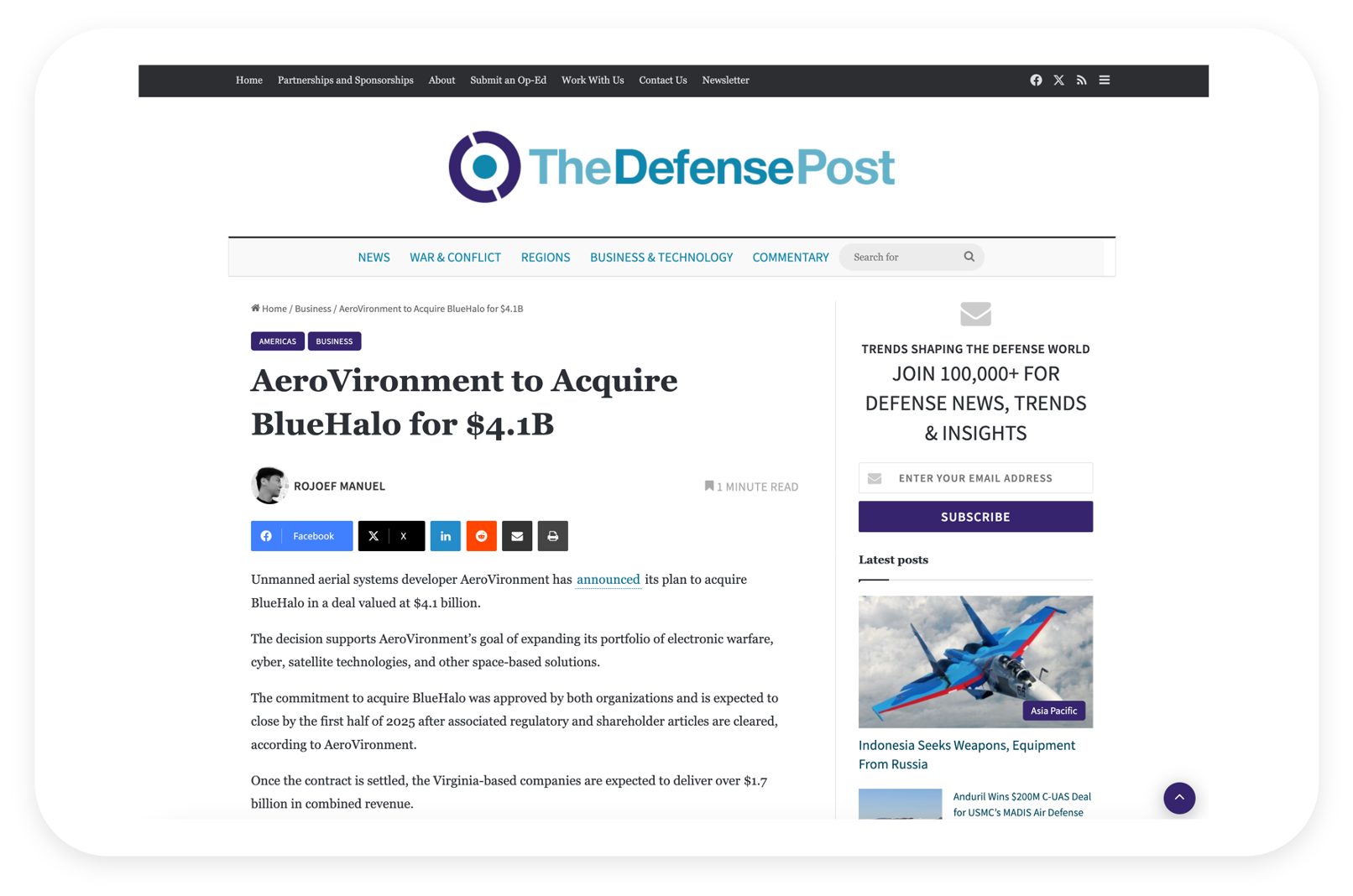
82. Critical Insight Acquired by Lumifi
Summary: Lumifi (formerly SilverSky), a managed detection and response (MDR) provider, acquired Critical Insight in late 2024. Critical Insight, founded by ex-CISO Mike Hamilton, offers MDR and cybersecurity-as-a-service with a strong focus on healthcare and public sector clients. This was Lumifi’s third acquisition in 13 months, following rebranding from Cygilant/SilverSky, as it aggressively consolidates the MDR market.
Strategic Advantages: The acquisition doubles down on Lumifi’s healthcare and critical infrastructure market presence. Critical Insight brings a 24/7 SOC, incident response team, and professional services that complement Lumifi’s threat monitoring and “ShieldVision” platform. Essentially, Lumifi broadens its service portfolio: adding Critical Insight’s incident response and vCISO consulting to its MDR tech stack. Geographically, Critical Insight’s West Coast roots (Seattle) and client base (hospitals, local governments) extend Lumifi’s reach. By integrating, they likely achieve some economies (shared SOC infrastructure, unified platform development) and can present a stronger value prop: full lifecycle cyber defense, from prevention to response, tailored for regulated sectors. The press release highlighted this strengthening of offerings and presence in healthcare/critical infrastructure. It’s part of Lumifi’s strategy to grow both organically and via acquisition, aiming to build enough scale to perhaps IPO or be acquired itself. Each acquisition (Infocyte, Cysiv earlier, now Critical Insight) added either technology or market share. With Critical Insight, Lumifi also gains experienced practitioners (e.g., Critical Insight’s leadership includes former government security officials) which bolsters credibility.
81. Applied Insight Acquired by CACI
Summary: Federal IT contractor CACI International acquired Applied Insight in late 2024. Applied Insight (AI LLC), backed by The Acacia Group, is a cloud and analytics firm specializing in secure cloud migration, DevSecOps, and advanced cyber for the U.S. intelligence community (IC).
Strategic Advantages: This acquisition enhanced CACI’s cloud and mission IT offerings, particularly for classified environments. Applied Insight brought its alt-cloud platform (for secure AWS/Azure in air-gapped settings) and analytics tools like SHIFT, which help simulate classified cloud setups locally – key for intel and defense clients. Integrating this, CACI can now offer full-stack enterprise IT modernization, from infrastructure to application development, with the high security the IC demands. It aligns with CACI’s strategy to invest in high-growth tech areas. Notably, Applied Insight’s work with agencies like DHS and DoD expands CACI’s customer footprint and contract vehicles. CACI’s CEO noted the combined business will “enhance cloud, cyber, and user productivity for secure networks in the IC”, indicating synergy with CACI’s existing intel support business. Financially, while terms weren’t disclosed, Applied Insight’s ~$40M+ revenue (estimate) adds to CACI’s ~$6B, so it’s a tuck-in focused on capability gains rather than scale. It also preempted competition – preventing rivals from acquiring that tech.
80. Amelia Acquired by SoundHound
Summary: SoundHound AI, Inc., known for voice AI and speech recognition, acquired Amelia (IPsoft’s Amelia) for $80M in August 2024. Amelia is a conversational AI and digital assistant platform (originally from IPsoft) used by enterprises for customer service and IT support automation.
Strategic Advantages: This acquisition significantly expanded SoundHound’s scale and product reach in the booming conversational AI market. SoundHound primarily offered voice interface tech (e.g., for automotive and restaurants) and had gone public via SPAC in 2022. By adding Amelia, a leader in enterprise AI agents, SoundHound doubled its customer count to ~200 (including Fortune 500 companies) and projected combined 2025 revenue of $150M. It allowed SoundHound to diversify from its core voice applications into the broader digital assistant space (text-based chatbots, call center AI, etc.) – a timely move as generative AI drives demand for advanced virtual agents. Financially, paying $80M (mostly cash/equity) for a company that raised ~$189M was a bargain. SoundHound also assumed Amelia’s existing enterprise contracts (with big names like BNP Paribas and Fujitsu) and deep AI tech stack. The synergy is clear: SoundHound’s voice understanding + Amelia’s conversational workflows = next-gen AI assistants across voice and text. Post-acquisition, SoundHound could offer an end-to-end voice and chat solution, enhancing upsell opportunities. The deal also improved SoundHound’s financial outlook after a rough 2023 (stock was down, layoffs happened). With Amelia’s $45M revenue on board, SoundHound inches closer to profitability while expanding markets (IT helpdesk automation, etc.)
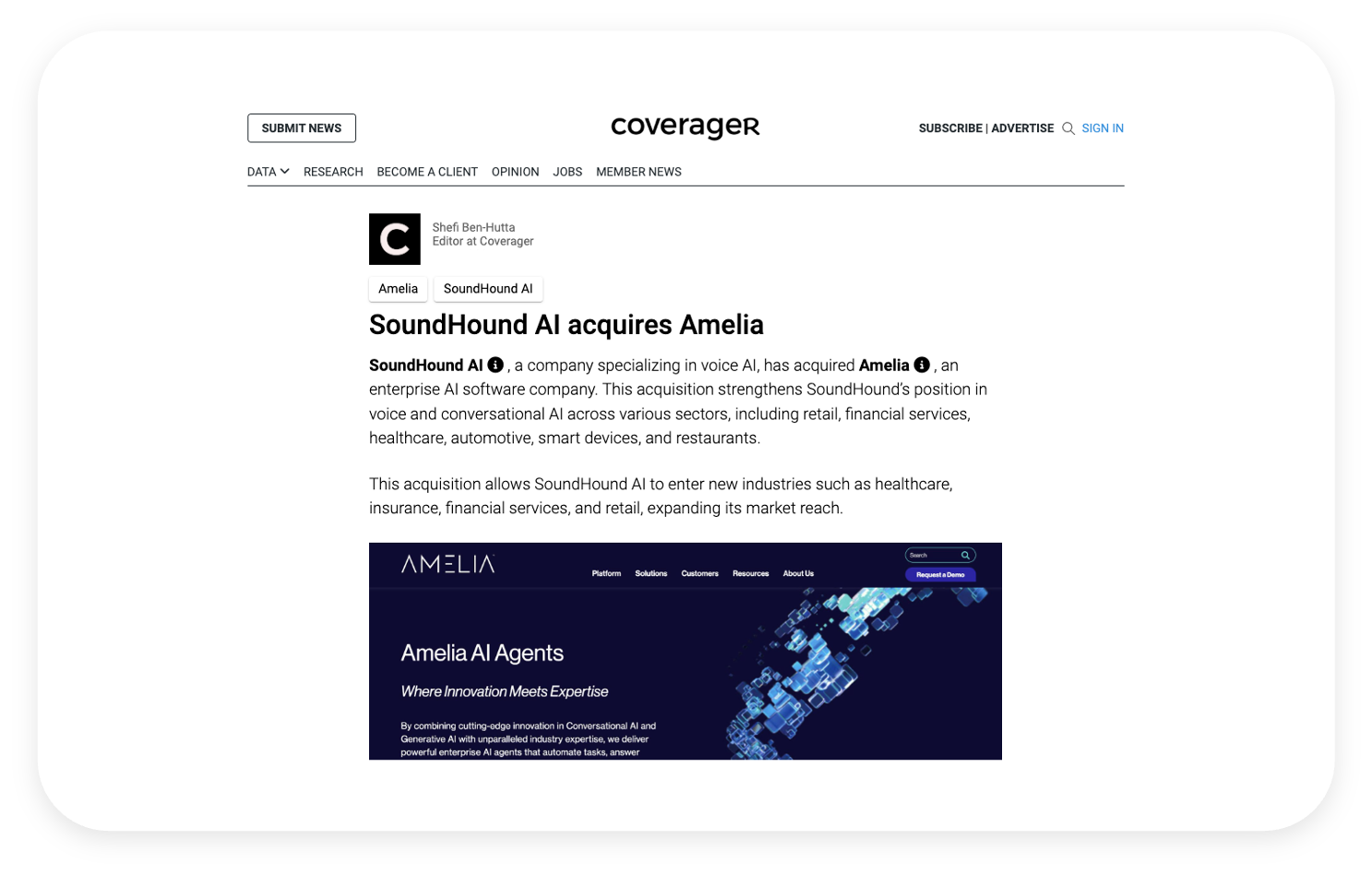
79. Marcum’s Non-Attest Business Acquired by CBIZ
Summary: In a major accounting industry deal, CBIZ, Inc. (a national professional services firm) acquired the non-attest business of Marcum LLP in early 2025, following Marcum’s splits from its audit practice (due to regulatory rules.) This effectively merged Marcum’s tax and consulting practice into CBIZ, making CBIZ a top-10 accounting firm with 160+ offices and 10,000+ employees.
Strategic Advantages: This acquisition propelled CBIZ into the elite ranks of accounting and advisory firms. By absorbing Marcum’s advisory business, CBIZ significantly expanded its geographic reach (Marcum was strong in the Northeast and Florida) and service offerings (like capital markets advisory, specialized consulting) without conflicting with audit independence (since attest stayed separate). CBIZ can now cross-sell a broader suite of services to both client bases, e.g., offering Marcum’s consulting expertise to CBIZ’s mid-market clients and vice versa. Economies of scale in back-office functions and vendor relationships will improve margins. Importantly, the combined firm’s national presence and talent pool make it more competitive for large engagements that require depth and breadth.
78. Challenger Acquired by Richardson Sales Performance
Summary: Richardson Sales Performance, a global leader in sales training and performance improvement, has acquired Challenger, the company behind the renowned “Challenger Sale” methodology. Challenger, founded in 2011, is known for its research-driven approach that helps organizations build high-performing sales teams by teaching reps to challenge customer thinking and drive insight-led conversations. The acquisition unites two of the most influential names in sales training, combining Challenger’s proven methodologies with Richardson’s scalable digital learning and performance analytics platform. Together, the companies aim to create the most comprehensive suite of sales enablement and performance solutions in the market.
Strategic Advantages: The merger brings together Richardson’s expertise in customized training delivery and sales transformation with Challenger’s deep intellectual property and behavioral science-based frameworks. This integration allows for end-to-end sales performance programs—from methodology design to digital reinforcement and analytics—under one brand.
By leveraging Challenger’s strong brand equity and Richardson’s global footprint, the combined organization is poised to accelerate growth across enterprise clients while expanding digital offerings. Strategically, this move reflects growing demand for data-driven, behavior-based sales enablement solutions that align training with measurable business outcomes.
77. Aeyon Acquired by CGI Federal
Summary: In late 2023, CGI Federal (U.S. arm of global IT firm CGI Inc.) acquired Aeyon, a rapidly growing consultancy specialized in AI, Robotic Process Automation (RPA), and financial management for U.S. federal agencies. Aeyon, backed by Enlightenment Capital, itself was formed by merging Artlin and Sehlke in 2021, with Bluetext’s help in branding (they crafted the Aeyon name and launch messaging, per their blog with CEO Sunny Singh discussing branding through M&A).
Strategic Advantages: For CGI Federal, acquiring Aeyon expands its capabilities in emerging tech and defense support services. Aeyon brings strong past performance in DoD financial management, Army robotics process automation, and Navy data analytics, complementing CGI’s traditional IT services. This helps CGI deepen relationships in national security agencies (Aeyon’s client list included defense and intelligence agencies). It also infuses entrepreneurial talent into CGI’s rather large organization – Aeyon’s leadership is known for agility and innovation. CGI cited the move as broadening its offerings in AI and automation for federal clients, aligning with government demand for digital transformation. Aeyon’s experience with the DoD’s financial systems and the JAIC’s AI initiatives can be leveraged across CGI’s wider client base. The acquisition underscores CGI’s strategy to grow via “build and buy,” adding niche expertise to bolster its federal footprint.
76. Axient Acquired by Astrion
Summary: Astrion, a Brightstar Capital Partners portfolio company, completed the acquisition of Axient (backed by Sagewind Capital) in September 2024. Astrion is a mission support and engineering contractor for U.S. government (recently formed, possibly combining former BRG assets), while Axient is a well-known defense and aerospace solutions provider (formed from a 2021 merger of QuantiTech, Millennium, Dynamic Concepts, etc.).
Strategic Advantages: By acquiring Axient, Astrion aims to set a new industry standard through enhanced scale and capabilities. The combined company addresses critical missions across defense and civilian agencies, spanning cybersecurity, systems engineering, space operations, and digital transformation. Essentially, Astrion + Axient creates a mid-sized powerhouse with end-to-end solutions, from R&D and testing (Axient’s forte in space and missiles) to operational mission support (Astrion’s focus). This breadth means they can bid on larger contracts and deliver more integrated offerings. For Axient’s customers (Space Force, Missile Defense, etc.), Astrion’s backing brings additional resources and capital to drive innovation – fulfilling the promise of “Accelerate Possible” that Bluetext helped brand. From Astrion’s perspective, acquiring Axient injects a large, experienced workforce (Axient had thousands of employees) and key contract vehicles, accelerating Astrion’s growth trajectory by years. The press release noted “benefits of scale” and expectation of substantial growth and exceptional outcomes. Private equity sponsors (Brightstar and Sagewind) also likely realize synergies: merging back-office functions and unifying go-to-market could improve margins.
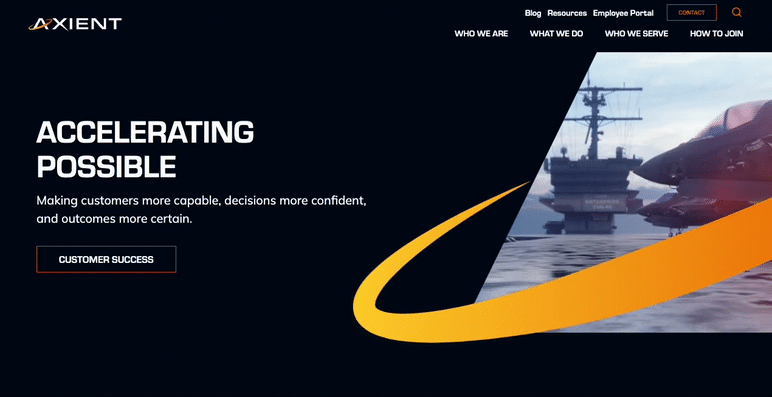
75. Courvoisier Acquired by Campari
Summary: Italian spirits company Campari Group acquired Courvoisier, the famed French cognac brand, from Beam Suntory for €1.1B (~$1.2B) in December 2023. This was Campari’s largest deal ever, bringing one of the “big four” Cognac houses into its portfolio.
Strategic Advantages: The acquisition solidifies Campari’s push into the premium brown spirits category. Courvoisier becomes Campari’s fourth pillar (after aperitifs like Aperol, bourbon, and tequila). Strategically, it gives Campari a renowned Cognac to compete with Diageo’s Hennessy partnership and Pernod Ricard’s Martell in key markets. Immediately, it boosts Campari’s sales by ~9% and brings a spirit category (cognac) that’s seeing growth in the U.S. and China. For Campari, which previously only had a smaller cognac (Bisquit) and Grand Marnier (an orange liqueur with cognac base), acquiring Courvoisier fills a portfolio gap and diversifies its revenue. It also provides scale in the supply chain for cognac (aging stocks, production in Jarnac, etc.). Campari can leverage its global distribution to expand Courvoisier’s reach, especially in Asia-Pacific where cognac demand is strong. The brand equity of Courvoisier (associated with luxury and even pop culture) adds prestige to Campari’s lineup. CEO Kunze-Concewitz, about to retire, called it a “crowning achievement”, signaling its strategic importance. Marketing-wise, Campari can now tell a richer story of being a curator of iconic brands from bitters to cognac, appealing to premiumization trends. They might invest in Courvoisier’s branding (packaging, campaigns) as they did after acquiring Grand Marnier.
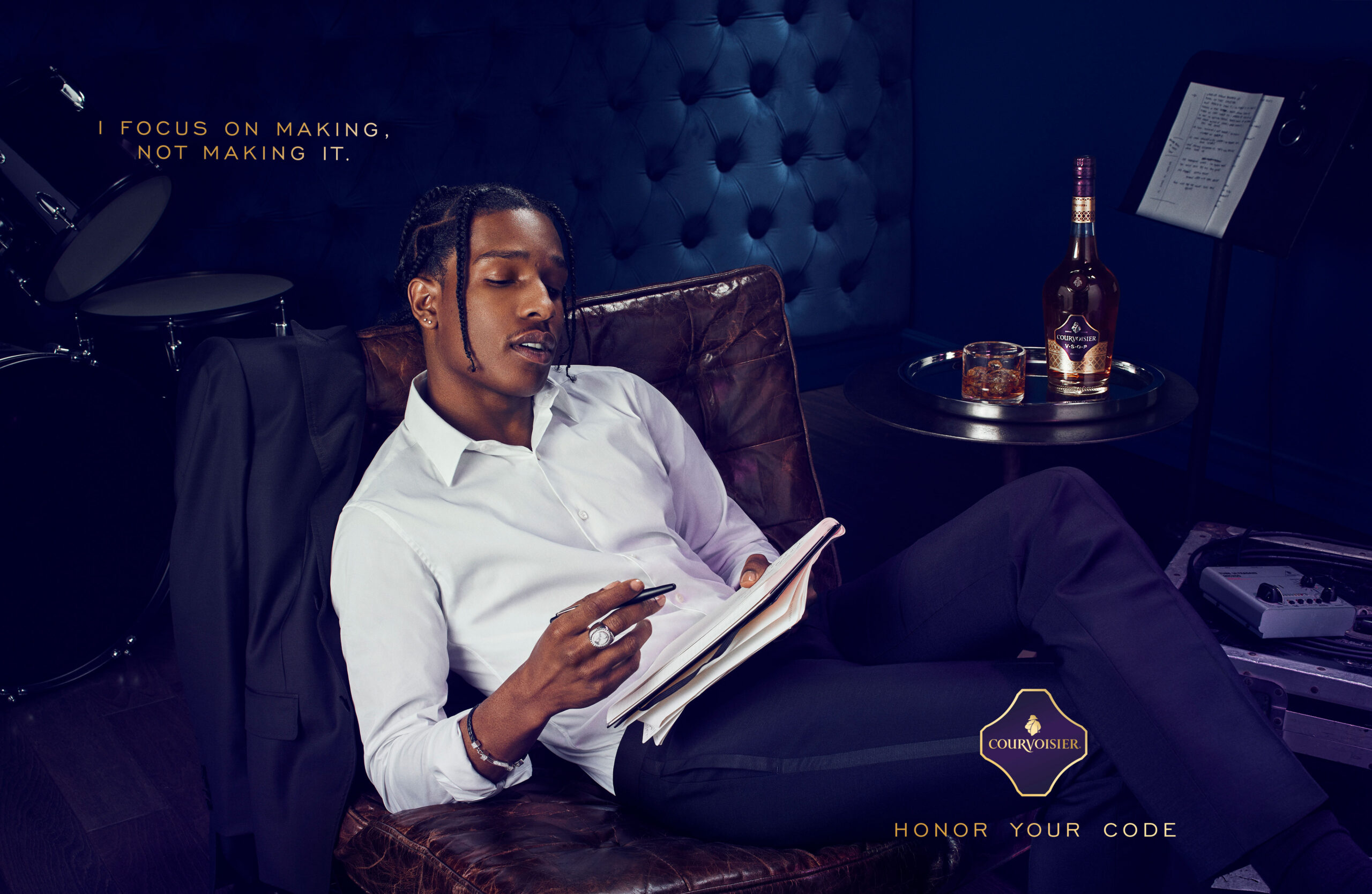
74. Keyloop Acquired Automotive Transformation Group (ATG)
Summary: UK-based automotive retail software provider Keyloop acquired Automotive Transformation Group (ATG) in May 2024. Keyloop (a Francisco Partners portfolio company, formerly part of CDK Global) offers dealer management systems (DMS) and digital solutions for car dealerships, while ATG (backed by Inflexion PE) provides an omnichannel e-commerce platform for car sales (from online reservations to showroom tools).
Strategic Advantages: The deal aims to create an integrated technology portfolio connecting the entire automotive consumer journey. By combining Keyloop’s back-end dealership software with ATG’s front-end retailing tools, the merged company can offer car manufacturers and dealers a seamless solution: from customer interest and online purchase, through financing and inventory management, to after-sales service. This meets the industry’s need for “omnichannel retailing” – consumers expect to transition smoothly between online car shopping and in-store experiences. Keyloop + ATG can facilitate things like online car configuration and pricing that flow directly into the dealer’s systems for a test drive or delivery scheduling. This streamlined customer experience can help dealerships increase sales conversions and improve customer satisfaction. Additionally, the acquisition expands Keyloop’s market share in Europe by adding ATG’s clients, and potentially allows cross-selling (Keyloop’s CRM or DMS to ATG customers, and vice versa). Efficiency-wise, integrated R&D can accelerate innovations like better data analytics for dealers.
73. Intelsat Acquired by SES
Summary: In April 2024, European satellite operator SES S.A. announced plans to acquire Intelsat for $3.1 billion in cash. This merger, pending regulatory approval (expected to close by late 2024 or 2025), would combine two of the world’s largest geostationary satellite services providers, creating a multi-orbit (GEO + MEO) communications behemoth.
Strategic Advantages: The SES-Intelsat merger would yield massive scale and synergies in the satellite industry. Together they’d control ~70 satellites and a deep global customer base in video, data, and government segments. SES touted €2.4B NPV in synergies (mostly cost savings and network integration benefits) with much realized within 3 years. A combined SES-Intelsat can offer customers integrated GEO and MEO (Medium Earth Orbit) solutions – SES’s O3b mPOWER MEO constellation complemented by Intelsat’s GEO fleet – to provide more flexible and resilient connectivity. This is crucial as competition from SpaceX Starlink (LEO) and others heats up; multi-orbit capabilities are a key differentiator. Additionally, consolidation reduces overlapping expenses in launch, ground infrastructure, and R&D, allowing more investment in next-gen satellites and services (like direct-to-device communication). For Intelsat, joining SES ends years of merger speculation and adds stability via SES’s stronger balance sheet. The combined entity can also better manage C-band spectrum transitions and monetization. Communication highlights include “creating a stronger and more competitive operator with expanded network and increased revenue in growth segments”.
72. Fastpath Acquired by Delinea
Summary: Privileged access management (PAM) company Delinea acquired Fastpath Solutions, an identity governance and access control software provider, closing in April 2024. Fastpath’s products help manage user access rights and SOD (segregation of duties) across business applications like ERP systems.
Strategic Advantages: The acquisition enables Delinea to offer an end-to-end identity security platform, blending PAM with Identity Governance and Administration (IGA). With Fastpath, Delinea can dynamically control user permissions in applications (like finance or HR systems) in addition to managing privileged accounts on servers and endpoints. This means customers get a unified view of who has what access and the ability to remediate risks (like over-privileged users or toxic combinations of access) automatically. As cybersecurity moves toward zero trust and least privilege, merging these capabilities is powerful. Delinea’s CEO said it solves complex identity challenges by connecting previously siloed solutions. It also positions Delinea against giants like CyberArk or SailPoint by having both PAM and IGA in-house. For Fastpath’s part, integration into Delinea’s cloud platform means its features can reach a wider market and be enhanced by Delinea’s identity threat detection tech. Communications perspective: likely emphasized “modernizing identity security with intelligent authorization”.
71. Eqlipse Technologies Acquired by BlueHalo
Summary: In early 2024, BlueHalo – a fast-growing defense tech firm – announced it will acquire Eqlipse Technologies, a provider of cybersecurity, signals intelligence, and cyber solutions to DoD and the Intelligence Community. Both were Arlington Capital portfolio companies, effectively merging under BlueHalo’s banner.
Strategic Advantages: Combining BlueHalo and Eqlipse creates a mid-tier defense tech powerhouse nearing $1B in revenue with 2,400 employees. BlueHalo gains Eqlipse’s high-end talent and products in cyber and RF sensing, enhancing BlueHalo’s capabilities in Space, c-UAS, electronic warfare, and AI. The merged entity can bid more competitively on large DoD programs, positioned as an alternative to the biggest primes by offering innovation without bureaucracy. Eqlipse was less than a year old under that brand, and now its identity and offerings bolster BlueHalo’s portfolio (indeed, BlueHalo cited Eqlipse’s contribution to Space Force’s $1.4B SCAR program). Culturally and strategically, both companies share a focus on rapid prototyping and mission-focused R&D, which the merger amplifies.
70. ZeroFox Acquired by Haveli
Summary: In May 2024, ZeroFox – a Baltimore-based external cybersecurity firm – was acquired and taken private by Haveli Investments for $350M. Haveli, a tech-focused PE firm in Austin, paid $1.14/share, a 45% premium on the 90-day stock price, and delisted ZeroFox from the Nasdaq.
Strategic Advantages: Going private under Haveli gives ZeroFox capital and strategic support to scale without public market pressure. Haveli likely sees long-term potential in ZeroFox’s platform (which includes AI threat intelligence, digital risk protection, and recent acquisitions like LookingGlass). With Haveli’s backing, ZeroFox can invest in R&D (perhaps developing new AI-driven threat disruption tools) and pursue new go-to-market channels (like MSSP partnerships or global expansion). The infusion of resources comes at a crucial time as cybersecurity threats proliferate; ZeroFox can now expand its external threat intelligence network and automation (“Disruption”) capabilities. Also, Haveli’s network might help ZeroFox land larger enterprise deals or federal contracts. For ZeroFox’s existing customers, Haveli’s ownership was positioned as a positive: more focus on innovation and customer success rather than quarterly earnings. Messaging from the CEO echoed this, noting the partnership will help “build a safer digital world” and accelerate product innovation. In short, as a private company ZeroFox can be more agile and aggressive in a fast-moving cyber market.
69. Kontron Americas Acquires Bsquare
Summary: Kontron Americas has acquired Bsquare, a leading provider of IoT enablement software and edge intelligence solutions. Bsquare’s expertise in device management, edge computing, and data orchestration enhances Kontron’s capabilities in delivering end-to-end industrial IoT and embedded computing solutions. The acquisition strengthens Kontron’s position across key verticals such as manufacturing, energy, and transportation by enabling smarter, more connected operations with scalable and secure edge-to-cloud platforms.
Strategic Advantages: Bsquare’s software-centric approach complements Kontron’s hardware portfolio, creating a comprehensive ecosystem that accelerates digital transformation initiatives for industrial customers. With deep experience in managing heterogeneous device fleets and optimizing data workflows at the edge, Bsquare enhances Kontron’s ability to deliver flexible, reliable, and secure IoT solutions. The combined entity benefits from broadened customer relationships across critical sectors and expanded R&D capabilities to innovate in AI-powered edge analytics, predictive maintenance, and real-time operational intelligence. Together, they are well positioned to capitalize on growing demand for integrated edge computing architectures that improve efficiency, reduce downtime, and enable actionable insights across industrial environments.
68. Verve Industrial Acquired by Rockwell Automation
Summary: Industrial automation giant Rockwell Automation acquired Verve Industrial Protection (an OT/ICS cybersecurity firm) in late 2023. Verve offers a unified platform for asset discovery, vulnerability assessment, and threat monitoring in operational technology (factory and utility networks).
Strategic Advantages: Rockwell’s acquisition of Verve reflects the trend of IT-OT convergence: marrying industrial controls with robust cybersecurity. By embedding Verve’s vendor-neutral OT security platform into its offerings, Rockwell can now deliver a turnkey solution to its manufacturing and energy customers – not just automating processes but also securing them. This is a critical differentiator as cyber threats to critical infrastructure rise. The move expands Rockwell’s suite in its software & services segment, likely offering Verve’s solution alongside Rockwell’s FactoryTalk software. Rockwell gains Verve’s domain expertise and its established client base in industries like oil & gas and utilities. Moreover, Verve’s capability to secure multi-vendor environments appeals to customers who run mixed control systems. Financially, at an estimated $190M price, it’s a relatively small acquisition for Rockwell with potentially big returns via new service contracts and recurring revenue (cyber monitoring subscriptions). In terms of marketing, Rockwell can now message a “secure automation” story: “We not only optimize your operations, we protect them.” That alignment of mission likely guided the communications around the deal, emphasizing enhanced reliability and safety for clients.
67. Ardent Acquired by Mission1st Group
Summary: Government IT contractor Mission1st Group acquired Ardent Management Consulting (Ardent MC) in mid-2024. Ardent is a 17-year-old digital transformation and geospatial analytics provider for federal agencies, and Mission1st (a veteran-owned firm) focuses on defense IT and engineering.
Strategic Advantages: This acquisition combines Mission1st’s defense market success with Ardent’s deep civilian agency expertise. Mission1st can now offer a broader slate of services – from military communications support to civilian agency cloud and data analytics – under one roof. For Ardent, joining Mission1st brings scale and access to Mission1st’s defense contracts, potentially opening new revenue streams (e.g., applying Ardent’s geospatial tech to DoD needs). The two companies’ capabilities are complementary, allowing cross-pollination of solutions (like Ardent’s location intelligence for Mission1st’s Army clients, or Mission1st’s cyber skills for Ardent’s DHS clients). Leadership quoted in the announcement highlighted leveraging “collective strengths” to enhance delivery for all customers. Strategically, the deal creates a mid-sized GovCon competitor with both DoD and civilian past performance – making them more competitive for large multi-agency IT contracts. Communications wise, the integration likely rebranded Ardent as “Ardent, a Mission1st company,” focusing on continuity of services.

66. RiskLens Acquired by Safe Security
Summary: Safe Security, a Palo Alto-based cyber risk management firm, acquired RiskLens in mid-2023. RiskLens is the pioneer of cyber risk quantification using the FAIR model (Factor Analysis of Information Risk). By joining forces, Safe Security aimed to create the undisputed leader in Cyber Risk Quantification (CRQ) and management.
Strategic Advantages: The combination marries RiskLens’ quantitative risk modeling with Safe’s real-time risk scoring platform, yielding a comprehensive view of cyber risk in financial terms. Customers benefit from automated, data-driven risk assessments that align with business impact – essentially, a “single pane of glass” for CISOs to prioritize security investments. Safe Security can now answer Board-level questions (“How much risk in dollars are we carrying?”) by leveraging RiskLens’ FAIR-standard calculations, something competitors may lack. This move differentiates Safe in the $4B CRQ market as a one-stop leader. Culturally, both companies focus on translating cyber metrics into business language, so integration is smoother. The strategic messaging is about transformation: “Together, we transform cyber risk management from guesswork into science.” This resonates with enterprise clients and was indeed the pitch – empowering customers with a real-time, standard model to manage risk proactively. In sum, Safe + RiskLens gives enterprises a powerful tool to make smarter, financially grounded security decisions, reinforcing Safe’s vision of holistic, AI-driven cyber risk management.
65. Imageware Systems Acquired by TECH5
Summary: Swiss-based biometrics company TECH5 acquired the assets of Imageware Systems (a U.S. biometric authentication firm) in early 2023. The deal included all software, patents, and key staff of Imageware, known for biometric identity management solutions for law enforcement and enterprise.
Strategic Advantages: This acquisition strengthened TECH5’s presence in North America and broadened its biometric product suite. TECH5, which provides fingerprint, face, and iris recognition tech, can integrate Imageware’s user-friendly biometric software (including its multimodal biometric management platform) to offer more complete solutions. Gaining Imageware’s patents accelerates TECH5’s innovation pipeline and possibly opens new verticals (Imageware had government and law enforcement clients). Importantly, TECH5 can reassure Imageware’s existing customers by continuing support and improving the acquired products with TECH5’s AI algorithms. The combination promises “the best UI and AI-driven authentication software” under one roof. Marketing wise, TECH5 pitched this as combining TECH5’s biometrics engines with Imageware’s proven front-end solutions, delivering more accurate and user-friendly ID systems.
64. VMware Acquired by Broadcom
Summary: Broadcom Inc. – known for semiconductors and enterprise software – acquired VMware for approximately $69 billion in a cash-and-stock deal. Finalized in late 2023 after regulatory delays, this landmark merger combined Broadcom’s infra and security software (CA, Symantec enterprise) with VMware’s cloud and virtualization suite.
Strategic Advantages: Broadcom aims to build “the world’s leading infrastructure technology company”. With VMware, Broadcom gains a dominant position in multi-cloud services used by enterprises globally. The strategic logic: pair Broadcom’s existing mainframe and security software with VMware’s cloud offerings to sell an integrated stack to large customers. The deal also nearly doubles Broadcom’s software revenue, diversifying beyond semiconductors. Broadcom touts significant synergies – both cost (via efficiencies, unfortunately including layoffs) and revenue (by cross-selling VMware to its clients). There are innovation benefits too: Broadcom’s resources can help VMware accelerate R&D in cloud networking, AI integration, and edge computing. For VMware users, Broadcom has pledged to continue support and investment (though some customers have warily watched pricing). Communication strategy would stress continuity and enhanced support: “VMware’s innovation + Broadcom’s scale = better solutions for your multi-cloud future”.
63. LookingGlass Acquired by ZeroFox
Summary: External cybersecurity firm ZeroFox (focused on digital risk protection) acquired LookingGlass Cyber Solutions for about $26 million in 2023. LookingGlass brought expertise in external attack surface management (EASM) and threat intelligence, complementing ZeroFox’s social media and digital threat hunting platform.
Strategic Advantages: The acquisition allowed ZeroFox to offer a full-spectrum external cyber risk platform. By folding in LookingGlass, ZeroFox added capabilities to monitor clients’ entire internet-facing footprint (domains, IPs, infra) and not just social/digital channels. This broadens ZeroFox’s value proposition to CISO customers: one vendor for brand protection, dark web monitoring, and attack surface reduction. Financially, acquiring at $26M (primarily in stock) was relatively inexpensive, leveraging ZeroFox’s then-public stock currency. Post-IPO, ZeroFox likely sought growth via acquisitions to meet shareholder expectations. With LookingGlass, ZeroFox could upsell new services to its base and attract larger enterprise deals with a more comprehensive suite.
62. Cvent Acquired by Blackstone
Summary: Event-management software leader Cvent was taken private by Blackstone in a $4.6 billion deal, completed mid-2023. Blackstone, a global PE firm, bought Cvent’s outstanding shares (at $8.50/share) and delisted the company from Nasdaq.
Strategic Advantages: As a private entity under Blackstone, Cvent can pursue long-term growth strategies away from public market pressures. Blackstone’s investment provides capital and industry connections (especially in hospitality) to help Cvent innovate its SaaS for meetings and events. The deal came as tech valuations dipped, giving Blackstone a bargain for a firm once valued higher. Blackstone can streamline Cvent’s operations (they reportedly planned cost cuts and workforce optimization) and potentially merge Cvent with other portfolio companies to expand its reach (e.g., combining with venue or travel tech assets). For Cvent, the infusion of resources and strategic guidance means accelerated development of its event marketing platform and possibly acquisitions of complementary tech (indeed, after going private, Cvent quickly acquired other software like Jifflenow.)
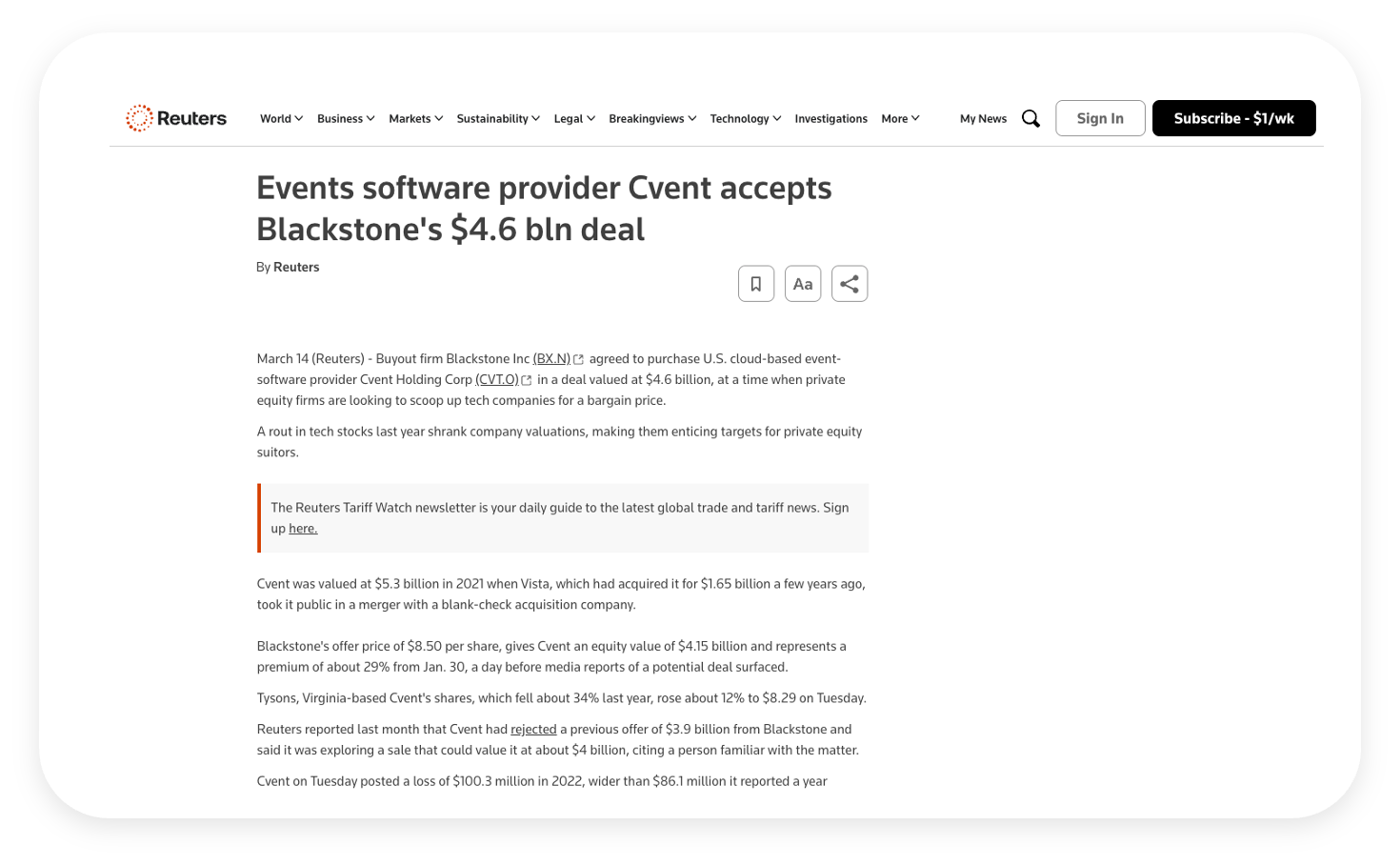
61. Paya Acquired by Nuvei
Summary: Nuvei, a Canadian fintech, acquired Paya (a U.S. integrated payments processor) for $1.3 billion in an all-cash deal, completed in February 2023. Paya specializes in payments embedded in software for sectors like non-profits, utilities, and B2B – complementing Nuvei’s global e-commerce payment platform.
Strategic Advantages: The acquisition created a payments powerhouse spanning global e-commerce and high-growth integrated payments. Nuvei gains Paya’s 300+ software integrations and strong foothold in U.S. B2B and government/utility payments. This diversifies Nuvei’s revenue streams, adding counter-cyclical stability (B2B and bill-pay tend to be less volatile than consumer retail). Technologically, plugging Paya into Nuvei’s platform enhances Nuvei’s offering with ACH processing, invoicing, and other capabilities Paya excels in. Nuvei’s CEO noted it speeds Nuvei’s growth into new verticals and allows them to offer a more comprehensive, “revenue-driving” payment solution to merchants.
60. Micro Focus Acquired by OpenText
Summary: In a mega-software deal, Canada’s OpenText acquired UK-based Micro Focus for roughly $6 billion. The acquisition (closed in early 2023) combined OpenText’s enterprise information management cloud software with Micro Focus’s legacy IT operations, security, and DevOps tools, nearly doubling OpenText’s revenue.
Strategic Advantages: OpenText’s goal is to become one of the world’s largest software and cloud businesses. By absorbing Micro Focus, OpenText instantly added a “tremendous marquee customer base” and expanded its product portfolio into mainframe software, cybersecurity, and IT management. There’s significant cross-sell opportunity: OpenText can offer its cloud-based information management to Micro Focus’s customers, while modernizing Micro Focus’s offerings with cloud and AI capabilities. The deal also promised ~$400M in cost synergies via consolidation, though it involved workforce reductions. This scale and breadth better positions OpenText against competitors like IBM.
59. CertainPath Merged with Mojio
Summary: CertainPath (formerly Success Group International), a provider of software and training for home service contractors, partnered/merged with Mojio to integrate Mojio’s connected fleet management platform (“Force by Mojio”) into CertainPath’s offering. This tie-up was described as joining forces rather than a full acquisition, but it effectively merges Mojio’s telematics services with CertainPath’s contractor management systems.
Strategic Advantages: The integrated solution provides home service businesses a seamless way to manage both operations and vehicles. CertainPath’s members (plumbers, HVAC, electricians, etc.) can access real-time van/truck tracking, driver safety scores, and maintenance alerts within the same platform they use for job scheduling and invoicing. This enhances operational efficiency: contractors reduce fuel costs and improve on-time service by routing and dispatching smarter. Mojio gains distribution to CertainPath’s nationwide member base, expanding its reach in the $650B home services market. By merging software and telematics, the partnership delivers an end-to-end solution competitors will find hard to match.
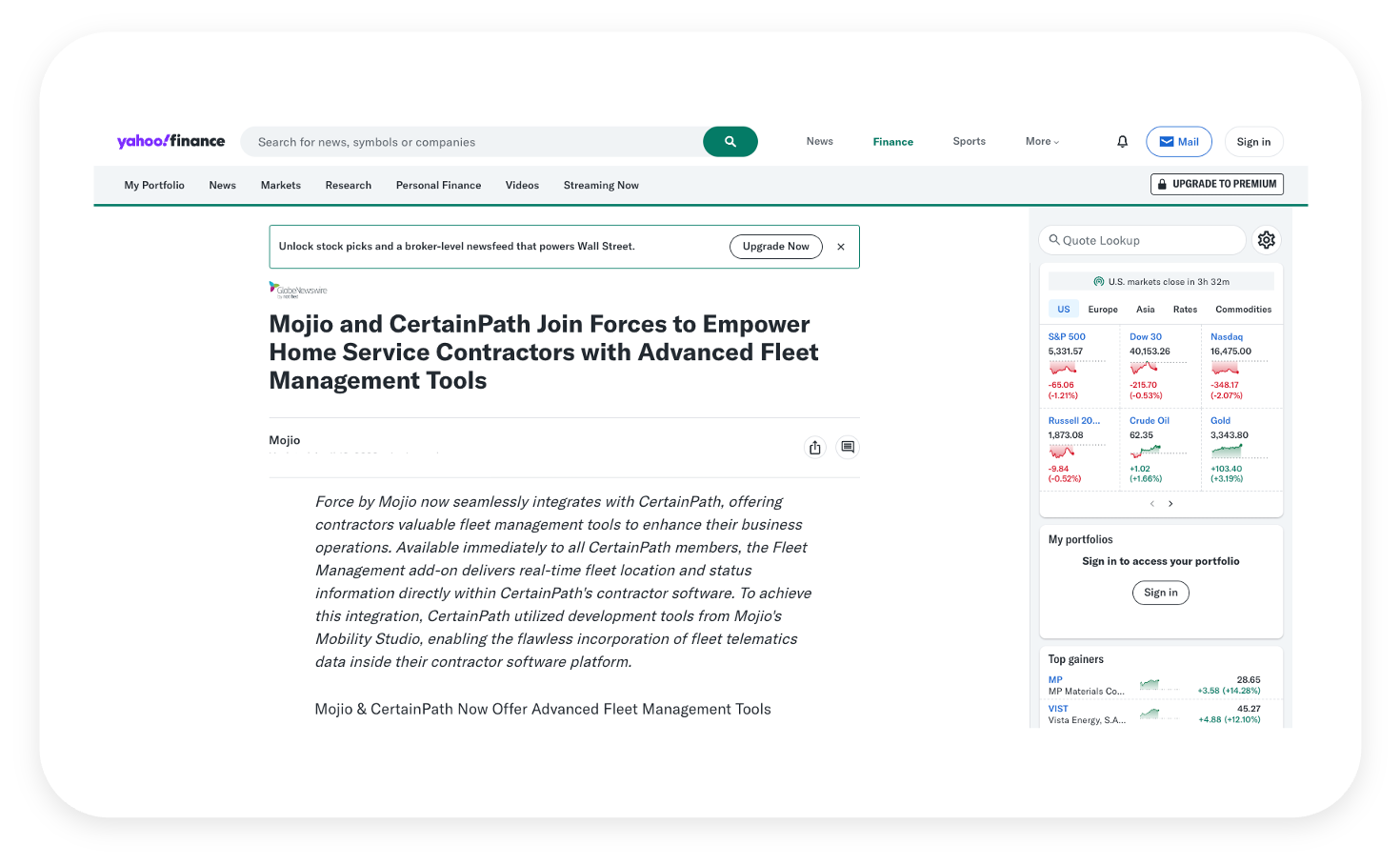
58. Revegy Acquired by Dura Software
Summary: Revegy, a sales optimization and revenue enablement software provider, was acquired by Dura Software in November 2022. Dura, known for buying “hyper-niche” software companies, made Revegy its 11th acquisition. Revegy’s platform helps enterprise sales teams manage complex accounts and relationships, functioning as a CRM-agnostic solution with 30,000 global users.
Strategic Advantages: With Revegy, Dura expanded its portfolio into sales enablement software, complementing existing holdings like 6Connex and Moki. The acquisition allows cross-pollination of technology and customers: Dura can infuse operational expertise and capital to grow Revegy’s product suite and market reach. For Revegy, joining Dura provides resources to innovate features (like AI-driven account insights) and enter new verticals under the umbrella of a company committed to “best-in-class” software solutions. Dura’s hyper-niche strategy means Revegy will receive focused attention to remain a leader in its segment. Bluetext’s emphasis on clear value storytelling in M&A would help communicate to Revegy’s clients that the acquisition strengthens long-term product support and innovation, reassuring them during the transition.
57. Dynamyx (Inspirata) Acquired by Fujifilm
Summary: Fujifilm Healthcare acquired the Dynamyx digital pathology business from Inspirata, integrating Inspirata’s FDA-cleared digital pathology platform into Fujifilm’s medical imaging portfolio. The deal included Dynamyx software, employees, and IP, giving Fujifilm a foothold in pathology informatics.
Strategic Advantages: For Fujifilm, acquiring Dynamyx accelerates its push into digital healthcare solutions. Fujifilm established a new digital pathology division to combine Dynamyx with its Synapse® Enterprise Imaging suite, aiming to integrate pathology images into hospital EHR systems. This creates a one-stop solution for radiology and pathology imaging, streamlining cancer diagnostics for care teams. Fujifilm can now leverage Dynamyx’s open architecture and multi-scanner support to challenge other industry players (like Philips). For Inspirata, the acquisition validated its technology and allowed its pathology innovations to scale globally under Fujifilm’s umbrella. BlueText’s earlier efforts in building Inspirata’s brand narrative around patient impact likely contributed to its credibility and appeal, showcasing the power of strategic branding in M&A outcomes.
56. SpaceIQ Merged with iOffice to Form Eptura
Summary: SpaceIQ and iOffice, key players in workplace management software, merged to form Eptura, a unified “worktech” powerhouse. This consolidation, backed by private equity firms Thoma Bravo and JMI Equity, pooled together SpaceIQ’s integrated workplace solutions (including legacy brands Archibus and Serraview) with iOffice’s asset management tools. The merger coincided with Condeco’s integration, as all three converged to create a comprehensive workplace experience platform.
Strategic Advantages: By forming Eptura, the companies expanded their market reach and product breadth. Eptura offers end-to-end workplace and asset management, addressing hybrid work challenges with solutions for space planning, resource scheduling, and asset tracking. The combined entity leverages shared R&D to accelerate innovation and respond to the evolving “future of work” demands. With Thoma Bravo and JMI’s backing, Eptura gains financial heft to invest in technology like AI-driven workspace analytics, plus cross-selling opportunities to a broad customer base. BlueText’s branding of SpaceIQ ensured the new venture launched with a strong digital presence, clearly communicating the benefits of the merger to customers and investors.
55. Illusive Acquired by Proofpoint
Summary: Proofpoint, a cybersecurity and compliance company, acquired Illusive, a leader in Identity Threat Detection and Response (ITDR).
Strategic Advantage: The acquisition strengthened Proofpoint’s threat and information protection platforms, providing customers with a unified solution to address identity-based threats.
54. E. Cohen & Company Merged into Marcum
Summary: Marcum LLP, a national accounting and advisory services firm, merged with E. Cohen & Company, CPAs, a Rockville, Maryland-based accounting firm.
Strategic Advantage: The merger expanded Marcum’s presence in the Mid-Atlantic region and enhanced its service offerings to clients in the area.
53. Octo Acquired by IBM
Summary: IBM announced the acquisition of Octo, a U.S.-based IT modernization and digital transformation services provider serving the federal government.
Strategic Advantage: The acquisition aimed to establish one of the largest digital transformation partners for the federal government, enhancing IBM’s consulting capabilities in the public sector.
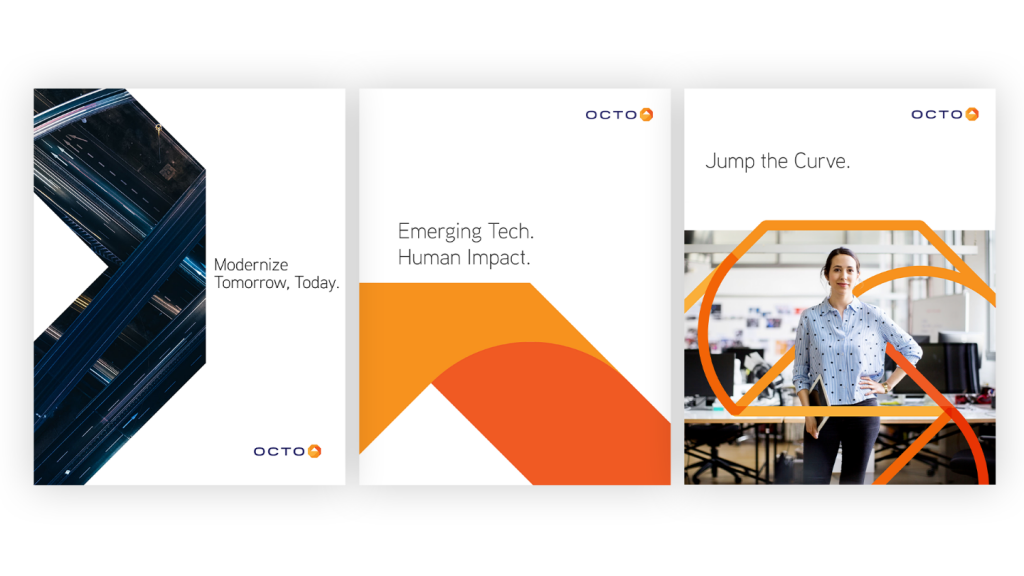
52. Cybeats Technologies Listed on the Canadian Securities Exchange
Summary: Cybeats Technologies Corp., a cybersecurity company specializing in Software Bill of Materials (SBOM) management and software supply chain intelligence, commenced trading on the Canadian Securities Exchange under the symbol “CYBT.”
Strategic Advantage: The listing provided Cybeats with access to public capital markets, enabling it to expand its cybersecurity solutions and address the growing demand for software supply chain security.
51. Level Access Merged with eSSENTIAL Accessibility
Summary: Level Access, a provider of enterprise digital accessibility solutions, merged with eSSENTIAL Accessibility, a pioneer of Accessibility-as-a-Service, to create a comprehensive digital accessibility solutions provider.
Strategic Advantage: The merger combined complementary technologies and expertise, accelerating the mainstream adoption of digital accessibility and offering end-to-end solutions for clients.
50. GCP Applied Technologies Acquired by Saint-Gobain
Summary: French construction materials leader Saint-Gobain acquired GCP Applied Technologies, a U.S.-based provider of specialty construction chemicals, for approximately $2.3 billion. GCP, known for its cement additives, concrete admixtures, and other high-performance building solutions, brought an established global footprint and complementary technologies to Saint-Gobain. This acquisition strengthens Saint-Gobain’s position in the construction chemicals sector and enhances its portfolio across high-performance and specialty building materials.
Strategic Advantage: The acquisition provides Saint-Gobain with an expanded product portfolio, incorporating GCP’s expertise in cement additives, concrete admixtures, and specialty construction chemicals, which complements the company’s existing CertainTeed and Chryso brands. GCP’s North American presence and international operations extend Saint-Gobain’s reach into key markets, while its proprietary technologies in high-performance building solutions strengthen Saint-Gobain’s innovation pipeline. Integrating GCP with Saint-Gobain’s CertainTeed and Chryso divisions is expected to improve operational efficiency and create new cross-selling opportunities. Overall, the combined entity positions Saint-Gobain as a global leader in construction chemicals, enabling growth in high-margin, specialized segments and reinforcing its competitive advantage in the industry.
49. ManTech Acquired by Carlyle Group
Summary: Global investment firm Carlyle Group acquired ManTech International, a cyber and technology contractor for defense, intelligence, and civilian agencies, in an all-cash transaction valued at approximately $4.2 billion.
Strategic Advantage: The acquisition aimed to leverage ManTech’s expertise in cybersecurity and technology solutions to enhance Carlyle’s portfolio in the government services sector.
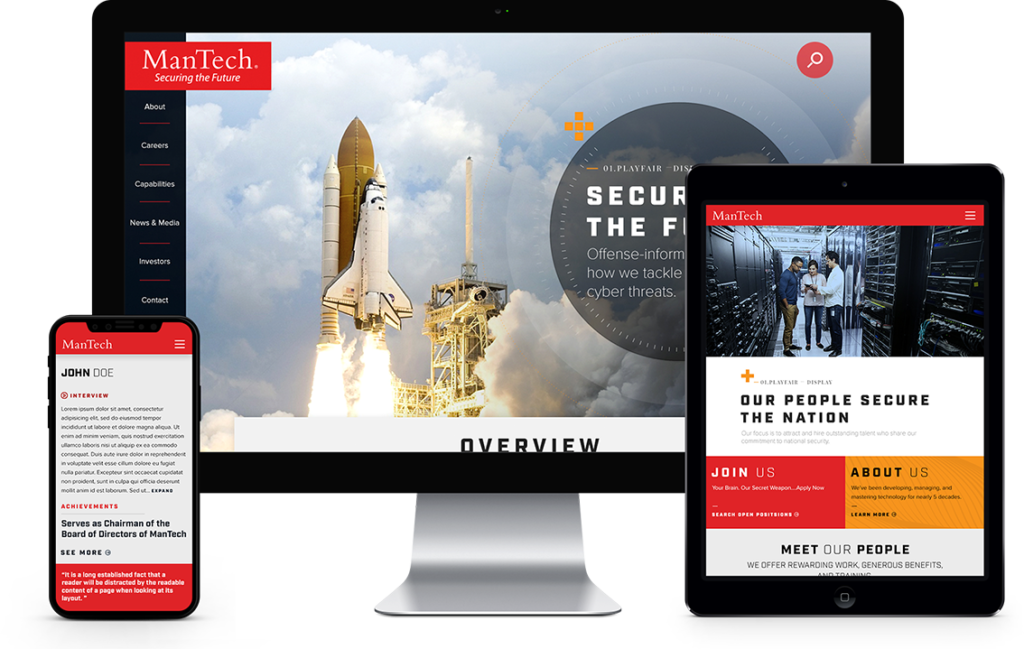
48. Citrix Acquired by Vista Equity Partners and Evergreen Coast Capital
Summary: Affiliates of Vista Equity Partners and Evergreen Coast Capital completed the acquisition of Citrix Systems, a leader in cloud computing and virtualization technology, in an all-cash transaction valued at $16.5 billion.
Strategic Advantage: The acquisition aimed to take Citrix private, allowing the company to accelerate its SaaS transformation and expand its platform for secure hybrid work solutions.
47. ID Technologies Acquired by CACI
Summary: CACI International acquired ID Technologies, an enterprise IT and network modernization provider with NSA-compliant Commercial Solutions for Classified (CSfC) technology.
Strategic Advantage: The acquisition expanded CACI’s secure network modernization capabilities, enhancing its offerings for U.S. government clients requiring classified communication solutions.
46. Cvent Goes Public via SPAC Merger with Dragoneer Growth Opportunities Corp. II
Summary: Cvent, a meetings, events, and hospitality technology provider, completed its merger with Dragoneer Growth Opportunities Corp. II, a special purpose acquisition company, and began trading on the Nasdaq as “CVT.”
Strategic Advantage: The merger provided Cvent with capital to accelerate product innovation and expand its market presence in the event technology sector.
45. Quest Acquired by Clearlake Capital
Summary: Clearlake Capital Group completed the acquisition of Quest Software, a global cybersecurity, data intelligence, and IT operations management software provider.
Strategic Advantage: The acquisition aimed to accelerate Quest’s growth and drive momentum in its cybersecurity and data intelligence solutions, leveraging Clearlake’s resources and expertise.

44. Narrative Science Acquired by Salesforce
Summary: Salesforce acquired Narrative Science, a data storytelling company, integrating its capabilities into Salesforce’s Tableau Software.
Strategic Advantage: This acquisition enhanced Tableau’s analytics platform by adding automated data storytelling features, enabling users to better understand and communicate data insights.
43. ResMan Acquired by Inhabit IQ
Summary: Inhabit IQ, a collective of tech-forward products serving the property management industry, acquired ResMan, a leading property management SaaS platform provider.
Strategic Advantage: This acquisition allowed Inhabit IQ to enhance its suite of solutions for multifamily and commercial property management, offering more comprehensive and integrated services to its clients.
42. BigBear.ai Goes Public via SPAC Merger with GigCapital4
Summary: BigBear.ai, an AI-powered analytics company, merged with GigCapital4, a special purpose acquisition company, to become a publicly traded entity.
Strategic Advantage: The merger provided BigBear.ai with capital to accelerate growth and expand its AI analytics offerings across various sectors.

41. Perspecta Acquired by Peraton
Summary: Peraton acquired Perspecta, a government services provider, to create a leading government technology solutions contractor.
Strategic Advantage: The acquisition combined complementary capabilities, enhancing Peraton’s ability to deliver comprehensive solutions to federal agencies.
40. Abaco Systems Acquired by Ametek
Summary: Ametek acquired Abaco Systems, a provider of embedded computing solutions, to expand its electronic instruments and electromechanical devices portfolio.
Strategic Advantage: The acquisition strengthened Ametek’s position in the defense and industrial markets, leveraging Abaco’s embedded computing expertise.
39. MuseDev Acquired by Sonatype
Summary: Sonatype acquired MuseDev, a software quality automation company, to enhance its software supply chain management platform.
Strategic Advantage: This acquisition allowed Sonatype to offer integrated code quality and security solutions, helping organizations manage and secure their software development processes.
38. Blue Yonder Acquired by Panasonic
Summary: Panasonic acquired Blue Yonder, a supply chain management software company, to enhance its autonomous supply chain capabilities.
Strategic Advantage: The acquisition enabled Panasonic to integrate Blue Yonder’s AI-driven supply chain solutions with its hardware offerings, providing comprehensive solutions for logistics and manufacturing clients.
37. Clarabridge Acquired by Qualtrics
Summary: Qualtrics acquired Clarabridge, a customer experience management platform, to enhance its experience management capabilities.
Strategic Advantage: This acquisition allowed Qualtrics to offer more robust customer insights and analytics solutions, strengthening its position in the experience management market.
36. Cloudera Acquired by KKR and CD&R
Summary: Investment firms KKR and Clayton, Dubilier & Rice (CD&R) acquired Cloudera, a data management and analytics company, to take it private and drive its next phase of growth.
Strategic Advantage: The acquisition provided Cloudera with resources and strategic guidance to enhance its product offerings and expand its market presence in the data analytics sector.
35. Alfresco Acquired by Hyland
Summary: Hyland acquired Alfresco, an open-source content services provider, to expand its content management capabilities.
Strategic Advantage: This acquisition allowed Hyland to offer a more comprehensive suite of content services solutions, catering to a broader range of industries and use cases.
34. PacStar Acquired by Curtiss-Wright
Summary: Curtiss-Wright acquired PacStar, a provider of tactical communications solutions, to enhance its defense electronics portfolio.
Strategic Advantage: The acquisition strengthened Curtiss-Wright’s offerings in battlefield communications, providing integrated solutions for military applications.
33. Centauri Acquired by KBR
Summary: KBR acquired Centauri, a provider of engineering and technology solutions for national security, to expand its defense and intelligence capabilities.
Strategic Advantage: This acquisition enhanced KBR’s position in the government solutions sector, allowing it to offer a broader range of services to defense and intelligence clients.
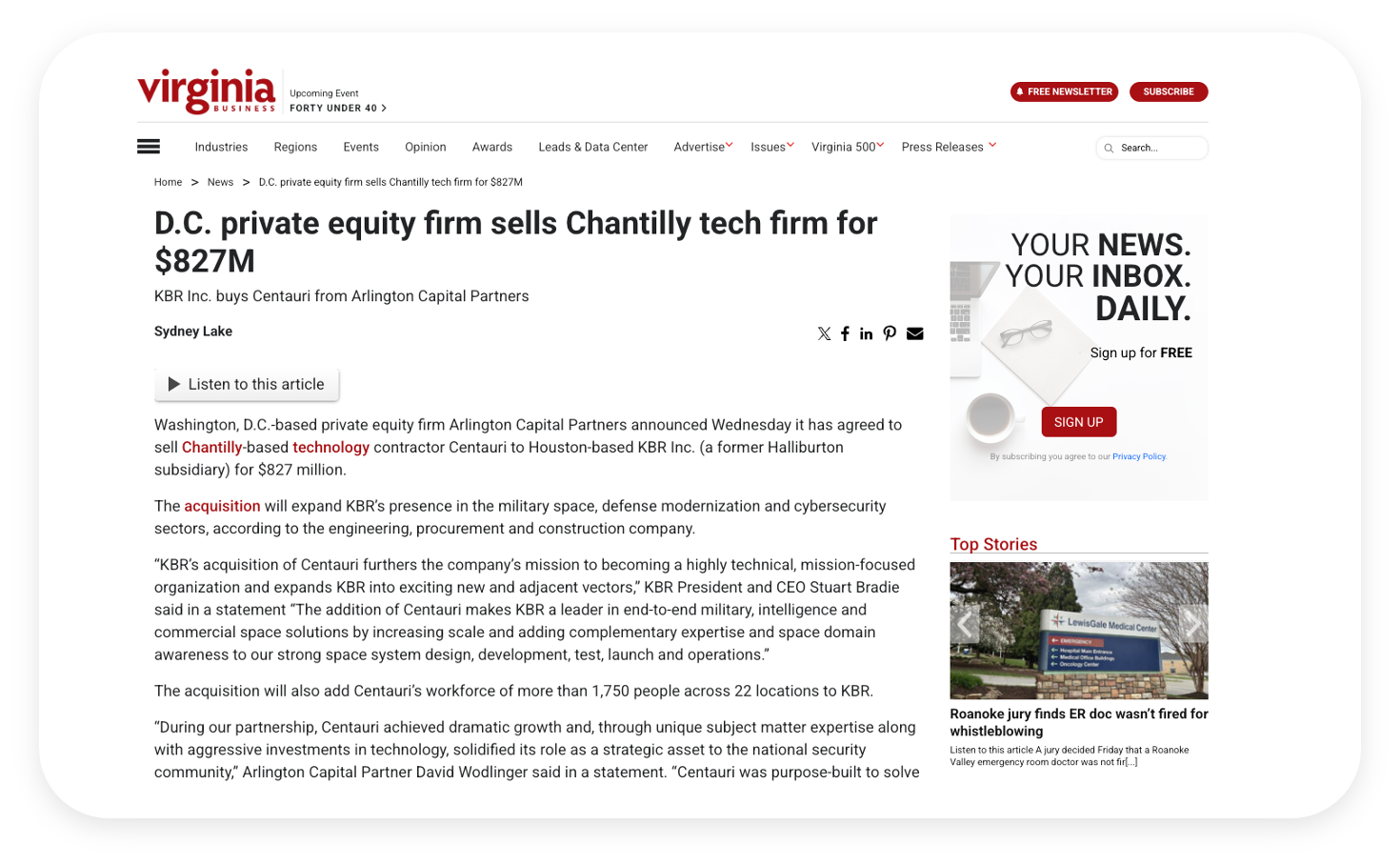
32. Paya Goes Public via SPAC Merger with FinTech Acquisition Corp III
Summary: Paya, a leading integrated payments and commerce solutions provider, went public through a merger with FinTech Acquisition Corp III, a special purpose acquisition company (SPAC), in late 2020. The transaction positioned Paya on the NASDAQ under the ticker symbol “PAYA,” enabling it to access public capital markets while continuing its strategic expansion across high-growth verticals such as healthcare, education, non-profit, and field services.
Strategic Advantage: The SPAC merger offered Paya both financial and strategic runway to scale its operations in a competitive and rapidly evolving fintech landscape. Paya’s move exemplifies how verticalized fintech platforms can leverage public markets—not just for liquidity, but as a catalyst for category leadership and innovation.

31. LGS Innovations Acquired by CACI
Summary: CACI International acquired LGS Innovations, a provider of C4ISR and cybersecurity solutions, to strengthen its offerings for defense and intelligence clients.
Strategic Advantage: The acquisition bolstered CACI’s capabilities in communications and cybersecurity, enhancing its ability to serve national security missions.
30. Bronfman Rothschild Acquired by NFP
Summary: NFP acquired Bronfman Rothschild, a wealth management firm, to expand its investment advisory services.
Strategic Advantage: This acquisition allowed NFP to enhance its wealth management capabilities, offering clients a broader range of financial planning and investment services.

29. KnightPoint Acquired by Perspecta
Summary: Perspecta acquired KnightPoint Systems, a cybersecurity and IT services firm, to bolster its cybersecurity offerings for government clients.
Strategic Advantage: The acquisition enhanced Perspecta’s ability to provide comprehensive cybersecurity solutions, addressing the critical needs of federal agencies.
28. GoCanvas Acquired by K1
Summary: K1 Investment Management acquired GoCanvas, a mobile platform for businesses to automate workflows, to accelerate its growth and product development.
Strategic Advantage: This acquisition provided GoCanvas with resources to enhance its platform and expand its market reach, strengthening its position in the mobile workflow automation sector.
27. Cority Acquired by Thoma Bravo
Summary: Thoma Bravo acquired Cority, a provider of environmental, health, and safety (EHS) software, to expand its investment in the EHS sector.
Strategic Advantage: The acquisition allowed Thoma Bravo to leverage Cority’s market position and technology to drive growth in the EHS software market.

26. Endgame Acquired by Elastic
Summary: Elastic acquired Endgame, a security company specializing in endpoint protection, to integrate security capabilities into its search and analytics platform.
Strategic Advantage: This acquisition enabled Elastic to offer users integrated security solutions, enhancing its platform’s appeal to organizations seeking comprehensive data analysis and protection.

25. Earth Networks Acquired by Union Park Capital
Summary: Union Park Capital acquired Earth Networks, a provider of weather intelligence solutions, to enhance its environmental monitoring portfolio.
Strategic Advantage: The acquisition allowed Union Park Capital to expand its offerings in the environmental data sector, leveraging Earth Networks’ technology and expertise.
24. Mindtree Acquired by L&T
Summary: Larsen & Toubro (L&T) acquired Mindtree, an IT services and consulting company, to expand its digital services capabilities.
Strategic Advantage: This acquisition strengthened L&T’s position in the IT services sector, allowing it to offer a broader range of digital transformation solutions to clients.

23. CQ Roll Call Acquired by FiscalNote
Summary: FiscalNote acquired CQ Roll Call, a provider of congressional news and legislative tracking, to expand its policy and analysis offerings.
Strategic Advantage: The acquisition enabled FiscalNote to provide clients with a more robust set of tools for policy monitoring and analysis, enhancing its value proposition in the legislative intelligence market.
22. BroadSoft Acquired by Cisco
Summary: Cisco acquired BroadSoft, a global leader in cloud-based communications, to enhance its cloud collaboration portfolio.
Strategic Advantage: This acquisition allowed Cisco to offer a comprehensive suite of unified communications solutions, strengthening its position in the cloud communications market.
21. PlanetRisk Federal Acquired by Culmen Technologies
Summary: In a move that deepens its national security and risk intelligence capabilities, Culmen Technologies acquired the federal business unit of PlanetRisk in early 2025. PlanetRisk Federal, known for delivering advanced geospatial, threat intelligence, and predictive analytics solutions to U.S. government agencies, strengthens Culmen’s footprint across the defense, intelligence, and homeland security markets. The acquisition aligns with Culmen’s strategy to expand its mission-critical support across the full threat lifecycle—combining operational expertise with enhanced data-driven insights.
Strategic Advantages: This acquisition brings immediate scale and capability lift to Culmen’s national security offerings. PlanetRisk Federal’s strengths in real-time situational awareness, data fusion, and predictive modeling directly complement Culmen’s existing programs in international security, logistics, and threat reduction.
20. PlanetRisk Acquired by Everbridge
Summary: Everbridge acquired PlanetRisk, a risk analytics company, to enhance its critical event management capabilities.
Strategic Advantage: This acquisition allowed Everbridge to provide more robust risk assessment and management solutions, strengthening its position in the critical event management sector.
19. Lithium Merged with Khoros
Summary: Lithium Technologies merged with Spredfast to form Khoros, a customer engagement platform.
Strategic Advantage: The merger combined complementary technologies, enabling Khoros to offer integrated solutions for customer engagement across multiple channels.
18. ThreatTrack (Vipre) Acquired by J2 Global
Summary: J2 Global acquired Vipre, a cybersecurity company, to expand its portfolio of internet security solutions.
Strategic Advantage: The acquisition allowed J2 Global to offer a more comprehensive suite of security products, enhancing its competitiveness in the cybersecurity market.
17. Endgame Acquired by Accenture Federal Services
Summary: Accenture Federal Services acquired Endgame, a cybersecurity firm specializing in endpoint protection, to bolster its security offerings for government clients.
Strategic Advantage: This acquisition enhanced Accenture’s ability to provide advanced cybersecurity solutions, addressing the critical needs of federal agencies in protecting against evolving cyber threats.
16. XO Communications Acquired by Verizon
Summary: Verizon acquired XO Communications, expanding its fiber-optic network and enhancing its enterprise service capabilities.
Strategic Advantage: The acquisition strengthened Verizon’s infrastructure, enabling it to offer improved services to enterprise customers and support the growing demand for high-speed connectivity.

15. NetWatcher Acquired by Qualys
Summary: Qualys acquired NetWatcher, a provider of network security solutions, to enhance its cloud-based security and compliance offerings.
Strategic Advantage: Integrating NetWatcher’s capabilities allowed Qualys to offer more robust and comprehensive security solutions, addressing the increasing demand for cloud security.
14. Sage Acquired by GTCR
Summary: Private equity firm GTCR acquired Sage Payment Solutions, aiming to expand its presence in the payment processing industry.
Strategic Advantage: The acquisition provided GTCR with a platform to capitalize on the growing electronic payments market, leveraging Sage’s technology and customer base.
13. CB&I Acquired by Veritas Capital
Summary: Veritas Capital acquired the Capital Services business of CB&I, enhancing its portfolio in government services and infrastructure.
Strategic Advantage: This acquisition allowed Veritas to expand its offerings in the government sector, leveraging CB&I’s established infrastructure projects and client relationships.
12. CSC Merged into DXC
Summary: The merger of Computer Sciences Corporation (CSC) and the Enterprise Services business of Hewlett Packard Enterprise formed DXC Technology, a global IT services leader.
Strategic Advantage: The formation of DXC Technology created a powerhouse in IT services, combining resources and expertise to offer a comprehensive range of solutions to clients worldwide.
11. Perthera Acquired by Pilot Growth
Summary: Pilot Growth Equity invested in Perthera, a precision medicine company, to accelerate its development of personalized cancer treatment solutions.
Strategic Advantage: This investment provided Perthera with the necessary capital to advance its innovative cancer treatment technologies, positioning it as a leader in the rapidly evolving precision medicine field.
10. Cigital Acquired by Synopsys
Summary: Synopsys acquired Cigital, a software security firm, to bolster its software integrity portfolio, providing comprehensive application security solutions.
Strategic Advantage: The acquisition strengthened Synopsys’s position in the software security market, enabling it to offer end-to-end solutions that address the increasing demand for secure software development.
9. Force3 Acquired by Sirius
Summary: Sirius Computer Solutions acquired Force3, enhancing its networking and security solutions offerings for federal agencies.
Strategic Advantage: This merger allowed Sirius to broaden its federal market footprint, providing comprehensive IT solutions and capitalizing on Force3’s established government contracts.
8. Abaco Systems Acquired by Veritas Capital
Summary: Veritas Capital acquired Abaco Systems, a provider of embedded computing solutions, to expand its portfolio in defense and industrial markets.
Strategic Advantage: The acquisition enabled Veritas to diversify its holdings and strengthen its presence in high-growth sectors, leveraging Abaco’s established relationships and technological capabilities.

7. Altimeter Acquired by Prophet
Summary: Prophet’s acquisition of Altimeter Group, a research and advisory firm, strengthened its digital transformation consulting services, offering deeper insights into emerging technologies.
Strategic Advantage: Integrating Altimeter’s expertise allowed Prophet to provide clients with cutting-edge strategies in digital transformation, enhancing its competitive edge in the consulting industry.
6. Acentia Acquired by Maximus
Summary: Maximus acquired Acentia, a provider of technology and management solutions, to enhance its capabilities in serving federal health and civilian agencies.
Strategic Advantage: This merger expanded Maximus’s service offerings in the government sector, allowing for a more comprehensive approach to IT and management solutions for federal clients.
5. Riverbed Acquired by Thoma Bravo
Summary: Private equity firm Thoma Bravo acquired Riverbed Technology, a leader in application performance infrastructure, aiming to drive innovation and growth in network optimization solutions.
Strategic Advantage: The acquisition provided Thoma Bravo with a robust platform in the network performance sector, enabling synergies that could lead to enhanced product offerings and market expansion.
4. HelloWallet Acquired by Morningstar
Summary: Morningstar’s acquisition of HelloWallet, a personal finance software company, expanded its financial wellness offerings, providing comprehensive tools for individual financial planning.
Strategic Advantage: This acquisition diversified Morningstar’s product portfolio, allowing it to cater to a broader customer base seeking integrated financial planning and investment solutions.
3. CyberArk Goes Public on NASDAQ
Summary: CyberArk, a pioneer in privileged access management (PAM), made its debut on the NASDAQ stock exchange, marking a major milestone in the evolution of enterprise cybersecurity. As one of the first cybersecurity firms focused solely on identity security to go public, CyberArk’s IPO signals increasing investor interest in solutions that protect against insider threats and credential-based attacks—two of the most pervasive risks in today’s digital landscape.
Strategic Advantage: Going public gives CyberArk the capital and visibility to accelerate its growth in a crowded identity security market. As organizations face mounting pressure to secure hybrid environments and zero trust frameworks, CyberArk’s PAM solutions are uniquely positioned to meet the moment.

2. SourceFire Acquired by Cisco
Summary: Cisco’s acquisition of cybersecurity firm SourceFire for $2.7 billion in 2013 bolstered its security portfolio, integrating advanced threat protection solutions.
Strategic Advantage: The acquisition allowed Cisco to enhance its cybersecurity offerings, providing comprehensive protection solutions and addressing the growing demand for advanced threat defense mechanisms.
1. Reznick Group Acquired by CohnReznick
Summary: CohnReznick’s acquisition of Resnick Group strengthened its position in the accounting and advisory sector, enhancing service offerings and expanding its client base.
Strategic Advantage: This merger enabled CohnReznick to achieve economies of scale, streamline operations, and offer a broader range of services to clients, thereby increasing market share and competitiveness.

What’s Next: M&A as a Messaging Moment
These 95 transactions reinforce a simple truth: M&A isn’t just a financial event—it’s a brand event. It’s the moment to reset perception, redefine value, and rally internal and external audiences around a new mission. That moment, if handled correctly, can drive retention, growth, and momentum. If not, it can cause confusion, churn, and missed opportunity.
That’s where Bluetext comes in.
We’ve helped brands navigate everything from stealth-stage mergers to IPO launches, PE rollups to post-acquisition integration. If your company is planning a transaction—or needs to reposition after one—let’s talk.
Contact Bluetext to start shaping the narrative that will define your next chapter.
Government contractors face a unique digital challenge: create an experience that checks every compliance box while still connecting with users. It’s a balancing act that requires more than just meeting federal standards—it demands thoughtful, human-centered design that engages stakeholders, builds trust, and supports mission delivery.
At Bluetext, we’ve worked with leading B2G organizations to tackle this challenge head-on. Here’s what it takes to align your UX with both federal requirements and user expectations.
The UX Landscape for Government Contractors
Unlike private sector sites that prioritize conversion funnels or sleek brand storytelling, digital platforms for government contractors must often serve multiple masters. They need to be:
- Compliant with strict accessibility and data security standards
- Clear and intuitive for a wide range of users, from contracting officers to program managers
- Aligned with the mission and values of the agencies they serve
Too often, this results in dense, overly technical websites that users find difficult to navigate. But poor UX doesn’t just frustrate visitors—it can undermine credibility, reduce engagement, and even impact contract wins. Great UX isn’t a luxury in the B2G space—it’s a differentiator.

Accessibility and Compliance: The Non-Negotiables
Section 508 compliance is the baseline for any government-facing digital experience. Alongside WCAG 2.1 guidelines, these standards ensure that websites are usable by people with disabilities, including those using screen readers, keyboard navigation, or alternative input devices.
But compliance doesn’t have to be a creativity killer. In fact, designing with accessibility in mind often leads to cleaner layouts, better content structure, and more usable interfaces for everyone.
Tools like Axe, WAVE, and Lighthouse can help identify issues early in the design process. Even more important is building accessibility into your workflow from day one—writing semantic HTML, designing for contrast and readability, and testing with real users when possible.
Compliance isn’t a one-time box to check. It’s an ongoing commitment that—when done right—enhances the overall experience.

Engagement Without Compromise
Just because your site has to follow the rules doesn’t mean it has to be boring. In fact, engaging design is often about doing more with less.
Here are a few UX principles that shine in the government space:
- Clarity over cleverness: Use plain language, intuitive labels, and clear visual hierarchy.
- Consistency builds trust: Standardize layouts, navigation, and interaction patterns to reduce friction.
- Guide the user journey: Employ subtle animations, progress indicators, and calls to action to keep users oriented and informed.
Small touches—like clean iconography, digestible content blocks, or a smart search function—can go a long way in making your digital experience more intuitive and user-friendly.

Building UX into the Proposal Process
UX shouldn’t be an afterthought—or an add-on once the development process is underway. Forward-thinking government contractors are baking user experience into their RFP responses, showing prospective clients how they’ll create usable, accessible solutions from the start.
This approach demonstrates not only technical know-how, but a genuine understanding of the agency’s end users and mission. By collaborating across design, development, content, and compliance teams early, contractors can avoid costly rework and deliver smarter, faster solutions.
Future Trends in Gov UX
The bar is rising for digital experiences—even in the public sector. Government buyers and stakeholders increasingly expect:
- Mobile-first functionality that works seamlessly across devices
- AI-enhanced interfaces for smarter content delivery and navigation
- Modular, design system-driven platforms that allow for scalable updates and consistency
- Human-centered cybersecurity, where secure doesn’t mean confusing
As these expectations evolve, the ability to deliver UX that’s both compliant and compelling will become a critical differentiator.

Partnering with Experts for Results
Designing UX for the government audience requires more than a basic understanding of Section 508. It requires an agency partner that understands the nuances of federal requirements, the strategic goals of B2G marketing, and the creative potential of great design.
At Bluetext, we specialize in creating digital experiences that meet the highest standards for accessibility and engagement—whether you’re responding to an RFP, redesigning a contractor portal, or launching a campaign microsite.
Is your digital presence working as hard as your proposal team? Contact Bluetext to build a UX that’s as smart, secure, and strategic as your business.
In an industry constantly chasing the next big thing, blockchain has loomed large as both a buzzword and a mystery. As marketers watch the evolution of Web3, the rise (and stumble) of NFTs, and calls for more secure, transparent digital systems, the question becomes: is blockchain marketing’s next breakthrough—or just another hyped-up distraction?
The truth, as usual, lies somewhere in between. Blockchain technology holds promise for reshaping how brands build trust, manage data, and deliver more transparent customer experiences. But turning promise into practice requires understanding what blockchain can (and can’t) do for marketing today.
Blockchain 101 (Marketing Edition)
At its core, blockchain is a decentralized ledger technology. Instead of data being stored in one central database, it’s distributed across a network of computers. Each transaction or data entry is verified and permanently recorded in a block, forming a secure, immutable chain of records.
So why should marketers care?
- Transparency: Blockchain’s public, verifiable nature means transactions—like ad impressions or product sourcing—can be tracked in real time.
- Security: Once data is on the blockchain, it can’t be tampered with. That’s a big deal for digital privacy and integrity.
- Decentralization: Reducing reliance on third-party platforms could give brands and users more direct control over data.
These features may sound abstract, but they open the door to several compelling marketing applications.

Emerging Use Cases in Marketing
Ad Fraud Prevention
Blockchain can help solve a long-standing digital advertising issue: fraud. By using blockchain to track ad delivery and engagement, marketers can verify whether impressions and clicks are legitimate. Several startups now offer blockchain-powered ad networks that ensure transparency throughout the media buying process.
Supply Chain Transparency
For brands that market ethically sourced or sustainable products, blockchain offers a way to verify and showcase the journey of goods—from raw material to retail shelf. This isn’t just a backend benefit; marketers can use verified data to build compelling, trust-based stories for consumers.
Customer Data Integrity
In a world where privacy matters more than ever, blockchain could allow users to control their personal data, granting marketers permission to use it in exchange for value. This creates opportunities for more transparent, consent-based personalization.
NFTs and Loyalty Programs
Brands like Starbucks and Nike have experimented with NFTs to create exclusive digital assets and perks. While some NFT campaigns were gimmicky, others hint at a future where loyalty programs become more personalized, gamified, and ownable by users.

Challenges and Limitations
Despite the potential, blockchain isn’t a turnkey solution. Marketers should be aware of key challenges:
- Scalability & Speed: Most blockchains still face performance issues, especially with large volumes of transactions.
- Energy Consumption: Proof-of-work systems like Bitcoin can be environmentally taxing, though newer consensus mechanisms are more sustainable.
- Complex Integration: Adding blockchain to a martech stack isn’t plug-and-play—it requires development, legal vetting, and user education.
- Audience Readiness: If your audience doesn’t understand or care about blockchain, the value might be lost.
What Brands Should Consider
Before diving into blockchain-based marketing, ask yourself:
- Does this enhance transparency or trust with our audience?
- Can we measure a clear return on this innovation?
- Are our customers tech-savvy enough to appreciate the benefits?
- Do we have the technical and compliance support needed to execute?
Early adopters are learning that success comes not from using blockchain for blockchain’s sake, but by aligning it with real customer value.

Between Hype and Opportunity
Blockchain isn’t a marketing miracle. But it’s not just hype, either. Its ability to create verifiable, secure, and decentralized experiences aligns with rising demands for transparency and control in digital interactions.
For marketers looking to future-proof their brand—and differentiate in an increasingly crowded space—blockchain may not be the next must-have, but it’s worth serious exploration.
Curious about how emerging tech can fit into your marketing stack? Contact Bluetext to explore what’s next for your digital strategy.
Large Language Models (LLMs) like GPT-4 and Claude have transformed how we generate content, automate support, and surface internal knowledge. While these models offer immense potential, B2B organizations are discovering that off-the-shelf versions often fall short of enterprise expectations. Generic tone, inconsistent outputs, and a lack of domain specificity can limit effectiveness. So how can B2B brands truly unlock the power of LLMs? The answer lies in optimization.
Why Generic LLMs Aren’t Enough for B2B
Out-of-the-box LLMs are trained on general internet data, which means they’re not designed to understand your industry, products, or brand voice. This leads to:
- Hallucinated facts and technical inaccuracies
- Off-brand tone and messaging
- Compliance and privacy risks
- Limited ability to serve nuanced enterprise use cases

Techniques to Optimize LLMs for B2B
Prompt Engineering: Crafting structured, context-rich prompts improves output relevance. Setting clear roles (e.g., “Act as a cybersecurity analyst”) or constraints (“Write in AP style”) can guide the model toward better responses.
Retrieval-Augmented Generation (RAG): This technique enriches LLM outputs with real-time access to enterprise-specific documents, ensuring factual, contextual answers pulled from your proprietary knowledge base.
Model Fine-Tuning: Training the model on your company’s data—such as product manuals, sales materials, and case studies—improves performance for specific applications. This results in more accurate, brand-aligned outputs.
Feedback Loops: Use internal teams or customers to rate and improve model responses over time. Feedback-driven reinforcement learning ensures ongoing optimization based on real-world usage.
Enterprise Use Cases for Optimized LLMs
- Sales Enablement: Auto-generate pitch decks, email templates, and product one-pagers that align with specific buyer personas.
- Customer Support: Deploy intelligent chatbots capable of resolving complex queries using your documentation.
- Internal Knowledge Management: Build assistants that help employees find the right information fast, reducing reliance on outdated wikis or manual search.
- Content Marketing: Streamline content creation for blogs, SEO, and social while maintaining brand tone and compliance.

Governance and Compliance Considerations
For B2B, especially in regulated industries, optimization must go hand-in-hand with governance:
- Enforce brand voice and tone through structured prompts and content templates.
- Ensure data privacy by keeping proprietary content secure during model training.
- Establish clear human-in-the-loop review processes for sensitive outputs.
Final Thoughts
Generic AI won’t cut it in B2B. By investing in LLM optimization techniques like prompt engineering, RAG, and fine-tuning, companies can unlock smarter, more scalable results across marketing, sales, and support. The key is starting with a strategy tailored to your goals, audiences, and compliance needs.
Ready to elevate your AI strategy? Contact Bluetext to explore how customized LLMs can deliver measurable value for your enterprise.
In the rapidly evolving digital landscape, brands are under increasing pressure to deliver consistent, high-quality content across a growing number of platforms and devices. Traditional content management systems (CMS) often struggle to keep up with these demands, which has led to the rise of a more flexible, developer-friendly alternative: the headless CMS. But what exactly is a headless CMS, and is it the right move for your brand?
What Is a Headless CMS?
A headless CMS is a backend-only content management system that separates the content repository (“body”) from the presentation layer (“head”). Unlike traditional CMS platforms like WordPress or Drupal, which couple content and frontend design into a single system, a headless CMS delivers content via APIs to any frontend you choose—websites, mobile apps, digital kiosks, or even smart devices.
This decoupled architecture gives brands the freedom to create omnichannel experiences while empowering developers to use modern frameworks like React, Vue, or Next.js.

Benefits of a Headless CMS
Omnichannel Delivery: One of the most significant advantages of a headless CMS is its ability to push content to multiple platforms from a single source, ensuring consistency across touchpoints.
Improved Performance: Headless setups can significantly reduce page load times and improve SEO by enabling developers to build fast, optimized frontends.
Developer Flexibility: With the frontend and backend decoupled, developers are free to choose the best tools for the job, rather than being locked into the templating systems of traditional CMSs.
Scalability: Headless CMSs are built to handle growth, making them ideal for enterprises managing global content operations.
Security: By removing the presentation layer from the content management system, the attack surface for potential threats is reduced.
Challenges and Trade-Offs
Complex Implementation: Transitioning to a headless CMS requires skilled developers and careful planning to integrate APIs and build custom frontends.
Editor Experience: Without a built-in preview or WYSIWYG editor, content creators may struggle to visualize how their work will appear on the final interface.
Maintenance and Cost: Managing a headless architecture involves more moving parts, which can increase ongoing maintenance efforts and costs.
Training Requirements: Your marketing and content teams will need time and support to adapt to the new workflows.

Is Headless Right for Your Brand?
A headless CMS is a powerful solution—but it isn’t for everyone. Here are a few indicators that it might be the right fit:
- You publish content across multiple digital channels.
- You need more flexibility than a traditional CMS can offer.
- Your development team wants to use modern frontend frameworks.
- You require enterprise-grade performance and security.
- You operate in multiple regions and need localized content delivery.
On the other hand, if your site is relatively simple and your marketing team relies heavily on visual editing tools, a traditional CMS might still be the better choice.
Real-World Use Cases
- B2B Tech Firms: Supporting complex product catalogs and knowledge bases across geographies.
- Consumer Brands: Delivering unified experiences across mobile apps, e-commerce sites, and interactive displays.
- Government Contractors: Meeting strict performance and security standards while serving diverse audiences.
Final Thoughts
Headless CMS represents a significant shift in how brands manage and deliver content. It offers agility, performance, and scalability—but it also comes with new responsibilities. If you’re looking to future-proof your digital presence, going headless could be a smart move.
Want to know if your CMS is holding you back? Contact Bluetext for a personalized CMS audit and digital architecture consultation.
Marketing to government audiences is a different game. Unlike commercial buyers, government decision-makers operate within a framework of strict procurement rules, risk mitigation priorities, and mission-driven goals. That means the messages that work in B2B or B2C settings often fall flat in B2G (business-to-government) environments.
To break through the noise and build credibility with government stakeholders, your marketing message needs to be sharp, structured, and strategically aligned with the public sector’s unique expectations. Here’s how to tailor your messaging to resonate with decision-makers in government.

What Makes Government Audiences Unique?
Government buyers are not just influenced by brand awareness or product features—they’re tasked with serving the public interest, meeting compliance standards, and ensuring taxpayer dollars are spent wisely. These decision-makers are typically risk-averse, procurement-focused, and guided by regulations.
It’s also important to understand that the government buying process involves multiple stakeholders:
- Technical experts who evaluate product feasibility.
- Program managers who care about mission alignment.
- Contracting officers who focus on price, compliance, and past performance.
Crafting messages that speak to each of these groups—without overcomplicating or overwhelming—is key.

Principles of Effective B2G Messaging
Government audiences respond best to messages that are clear, credible, and connected to their mission. Here are some essential principles to follow:
- Mission First: Frame your offering in terms of how it supports the agency’s objectives or improves public outcomes.
- Proof Over Promotion: Back every claim with data, use cases, or credentials. Flashy slogans don’t hold weight—facts do.
- Trust and Compliance: Emphasize security standards, certifications (like FedRAMP or CMMC), and contract history to reduce perceived risk.
- Simplicity is Strength: Avoid industry jargon or buzzwords. Speak plainly, directly, and with authority.
Tailoring Your Message for the Government Buying Cycle
The government decision-making process is long and layered. Your messaging should adapt to each phase of the journey:
- Awareness: At this stage, government stakeholders are seeking information—not sales pitches. Educational content like white papers, webinars, or industry briefings can help establish your credibility.
- Consideration: Here, decision-makers want to understand how your solution stacks up. Highlight differentiators, technical capabilities, and mission relevance with tailored solution briefs or case studies.
- Decision: Now it’s about procurement. Make it easy for buyers to justify your solution—share past performance, articulate ROI, and demonstrate compliance. Clear pricing structures and acquisition paths matter.

Best Practices for Connecting with Government Audiences
To ensure your messaging lands with impact, keep these best practices in mind:
- Use Plain Language: Government audiences appreciate direct, jargon-free communication that gets to the point quickly.
- Tailor Content Formats: Capability statements, compliance checklists, and executive summaries are more effective than flashy brand decks.
- Address Agency Pain Points: Customize your messaging to reflect the specific challenges, mandates, or priorities of the agency you’re targeting.
- Be Consistent Across Channels: Whether it’s a website, digital ad, or RFI response, your brand message should reinforce trust and reliability every step of the way.
Positioning for Long-Term Success
Winning a government contract often takes time, persistence, and strategic alignment. The right messaging can open doors, but it’s consistency and clarity that keep them open. Government buyers want to work with partners who understand their world—who speak their language, anticipate their needs, and deliver on their promises.
At Bluetext, we specialize in helping brands craft B2G messaging that resonates with government audiences—combining strategic insight, content precision, and compliance know-how.
Ready to refine your message for government audiences? Bluetext helps B2G brands connect with decision-makers through precision messaging, content strategy, and campaign execution. Let’s start the conversation.